Hibiscus. A flower quite like no other. Appearing in all her glory in the morning, and then fading as the evening sun casts long shadows amongst the trees.
I remember this flower well, from my childhood home, a bougainvillea-clad house on the coast of East Africa, with fragrant frangipani and the bright red of the hibiscus.
My mother was a keen gardener, tending tropical native flowers with an artist’s flair, getting just the right balance between “wild and free,” and “tame and homely.”
In the rocky soil of the ancient coral cliffs on which our house was built, desert roses bloomed beneath a large, imposing baobab tree.
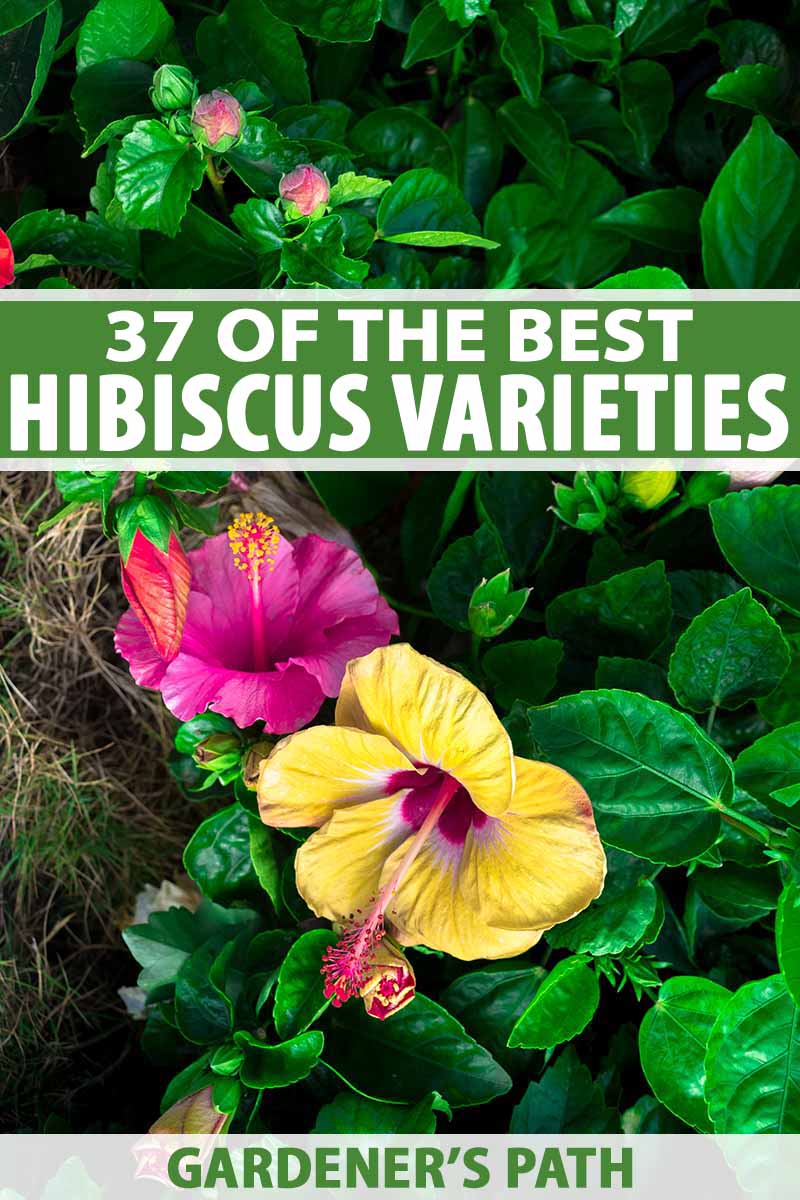
We link to vendors to help you find relevant products. If you buy from one of our links, we may earn a commission.
At the back of our house, we had a lush mango tree, replete with delicious fruit, which as children we would have to grab before the monkeys had their fill.
But my favorite flower was always the hibiscus, billowing gently in the soft sea air.
That vivid red, fading slightly towards the edges with a dark center, and the strange, long staminal column with fuzzy yellow pollen at the end always had me enthralled.
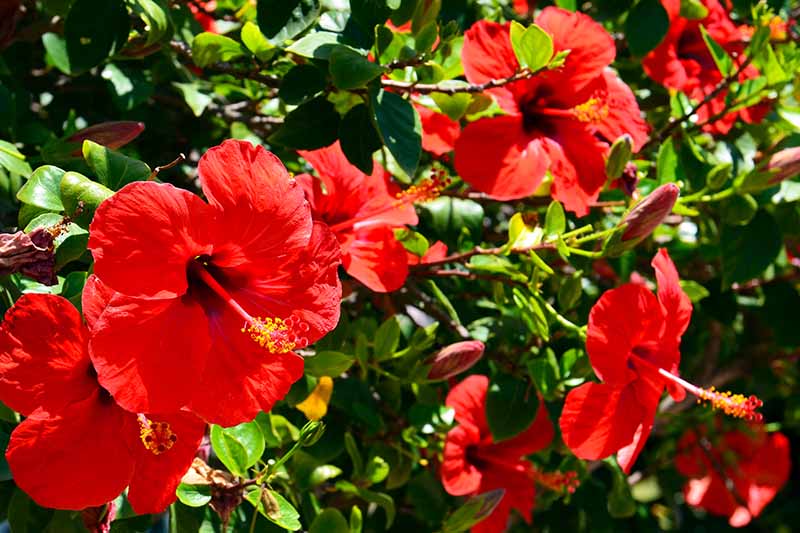
Living now in what I would describe as the “frozen south” – anything other than the tropics feels cold to me – I had no idea that it was possible to add my childhood favorite to the garden.
Turns out, it is.
Several hundred different species of the genus Hibiscus exist, and thanks to the work of many dedicated hybridizers, stunning cultivars are available in a variety of vivid colors, from cool blue to vibrant red – and most in between.
Except for green. I haven’t found a green hibiscus flower. Have you?
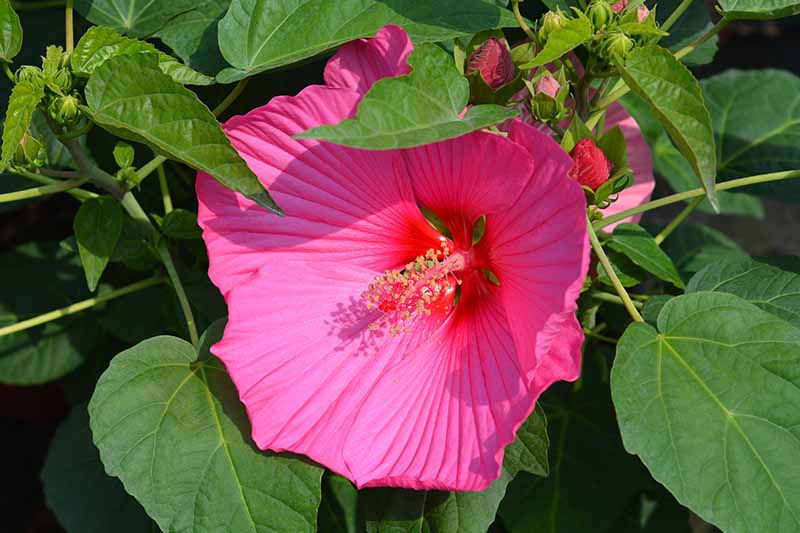
Narrowing down this list was the trickiest task of all. There wasn’t one I didn’t love! Well, maybe. I’ve found varieties suitable for growing as far north as USDA Hardiness Zone 4, as well as my tropical favorites.
Let’s dive into the colorful world of hibiscus.
A Hibiscus Primer
Of all the numerous species of hibiscus plant growing across the temperate, subtropical, and tropical regions, there are really only three that are grown commonly in North American gardens.
For the purposes of this roundup, I’ll be concentrating on three basic categories:
Hardy hibiscus, rose of Sharon, and tropical hibiscus.
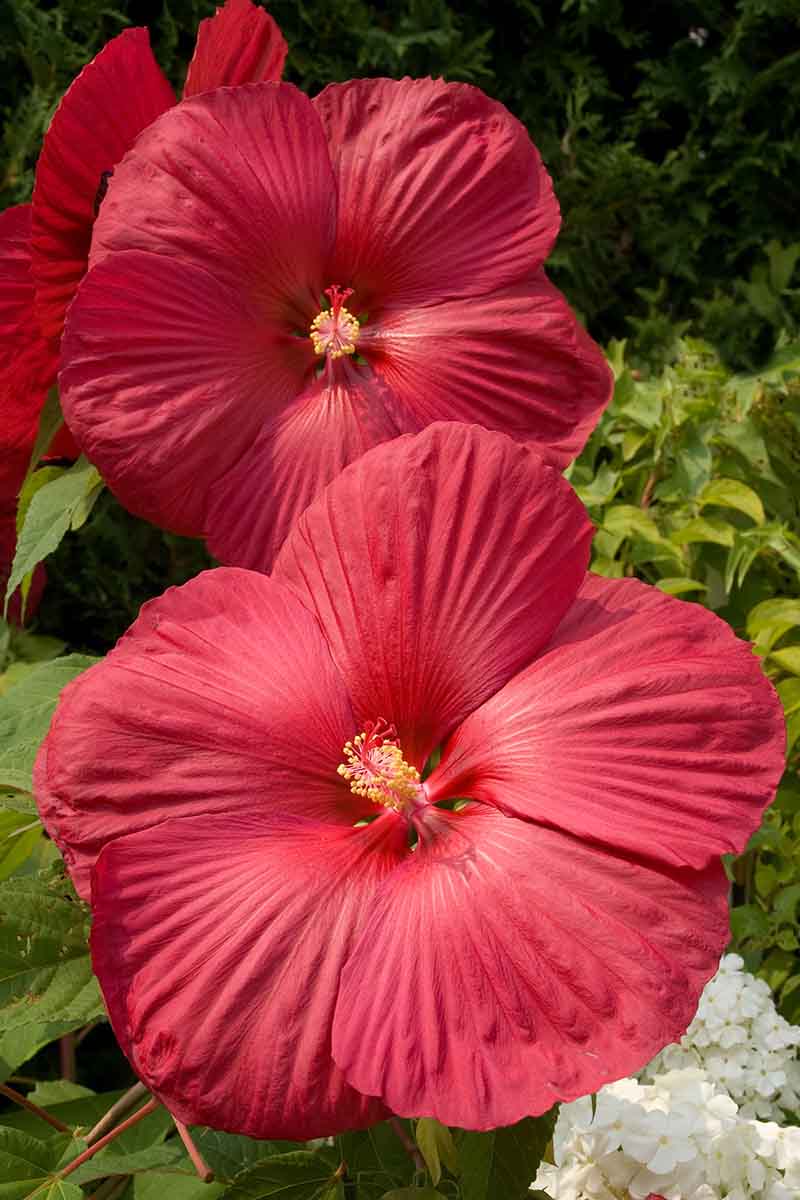
Those falling into what’s called the “hardy hibiscus” category, that comprise hybrids of the US native H. moscheutos species, also known as rose mallow; as well as cultivars of H. syriacus, also known as “rose of Sharon.”
These two are suitable for gardeners in Zones 4-9 – although winter protection may be required in colder regions.
You can learn more about growing hardy hibiscus here.
For growers in Zone 10 (and possibly Zone 9b if you provide winter protection) and above, I’ve got some stunning options of tropical hibiscus for you.
These are all cultivars and hybrids of H. rosa-sinensis, the Chinese hibiscus. I should mention that it’s possible to grow these as annuals in colder regions as well. Or as indoor plants, in containers.
Find tips on growing tropical hibiscus here.
Like many close relations, members of the Hibiscus genus are a complicated bunch.
They are members of the mallow family, Malvaceae, comprised of a whopping 244 genera, which includes the hollyhock genus, Alcea, the California tree mallow, Malva assurgentiflora, and the basswood tree, Tilia genus – also known as a “lime tree,” but having no relation to the fruit of the same name.
Confused yet?
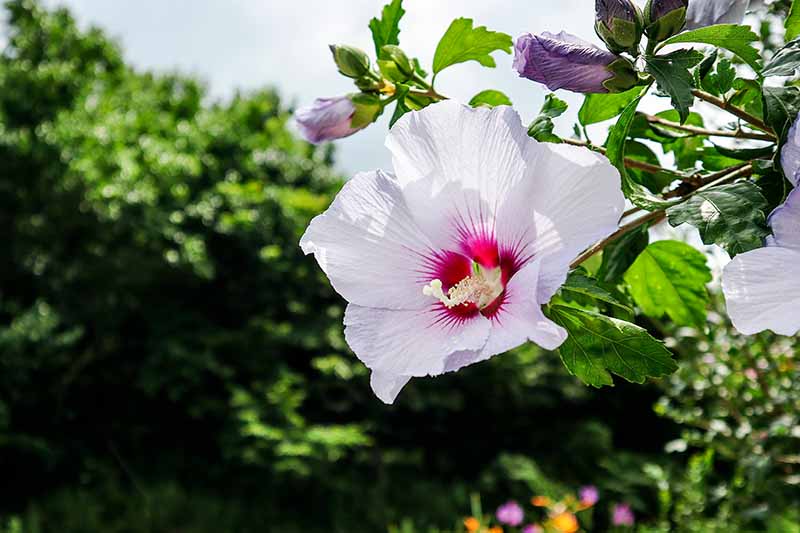
The perennial hibiscus flowers, some of which are hardy to Zone 4, are mostly cultivars of native US wildflowers, commonly called rose mallows. These generally grow wild in swampy, sunny areas, from Florida to Minnesota.
Several species exist in the wild, but clever hybridizers concentrate mainly on breeding hybrids of the H. moscheutos species, sometimes crossed with H. coccineaus.
Some form a short, dense habit, others are more reminiscent of their wild ancestors and can grow up to ten feet tall.
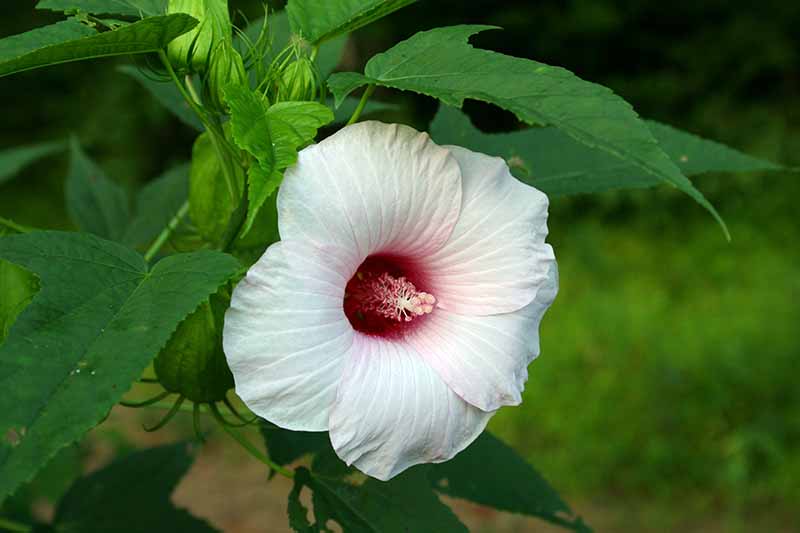
They enjoy full sun, moist – but not waterlogged – soil, and will happily bloom from early to midsummer all the way through fall, with large, 6 to 8-inch flowers in some stunning hues.
In the autumn, the foliage will die back, and reappear again in late spring, often much later than other perennials in your garden – just about the time when you’d given up on a season of showy flowers to follow.
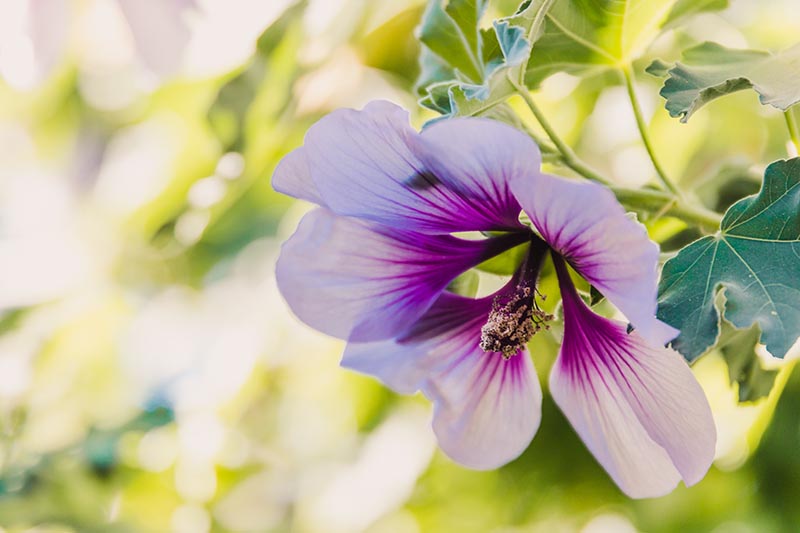
Then we have H. syriacus, also known as Althea, a hardy, deciduous shrub that is native to China and India, though naturalized through many parts of southern Europe.
This vigorous grower has a naturally vase-shaped, shrubby form, and growing it is an easy way to add a touch of the tropics to your temperate garden.
The national flower of Korea, H. syriacus will also die back and go dormant in the winter, reappearing in late spring.
Flowers usually last for just one day, but it will bloom profusely through the summer and into fall if given a rich, well-draining soil and a sunny location.

The blooms can be single or double, and they are usually slightly smaller than the native hybrids, coming in at three to five inches.
The doubles divert from the “classic” hibiscus we know and love, but they provide unique interest in the garden.
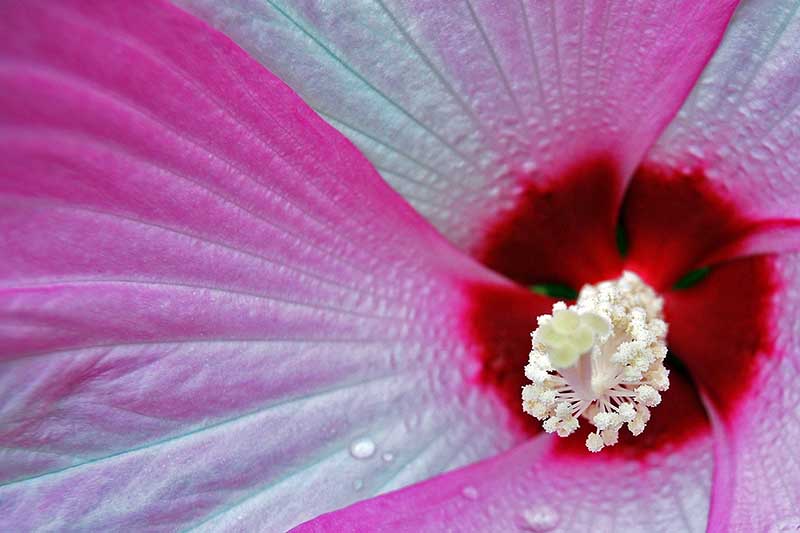
Some varieties of the hardy types are suitable for container growing, but they do need to be outdoors. The tropical varieties can be grown indoors in cold locations. But they don’t like it much, and can be tricky.
Lastly, the tropical species. Even this gets a little complicated. Today’s H. rosa-sinensis is an entirely cultivated – or manmade – plant.
The original H. rosa-sinensis was native to China, but the modern day cultivars are all hybrids of 8 original tropical species, ranging from Hawaii, Madagascar, and Mauritius, through China, to Fiji.
The modern tropical species we find in the US can be traced back to these eight ancestral species, that thanks to extensive hybridization – both naturally occurring and cultivated – are barely found growing wild in their original form any more.
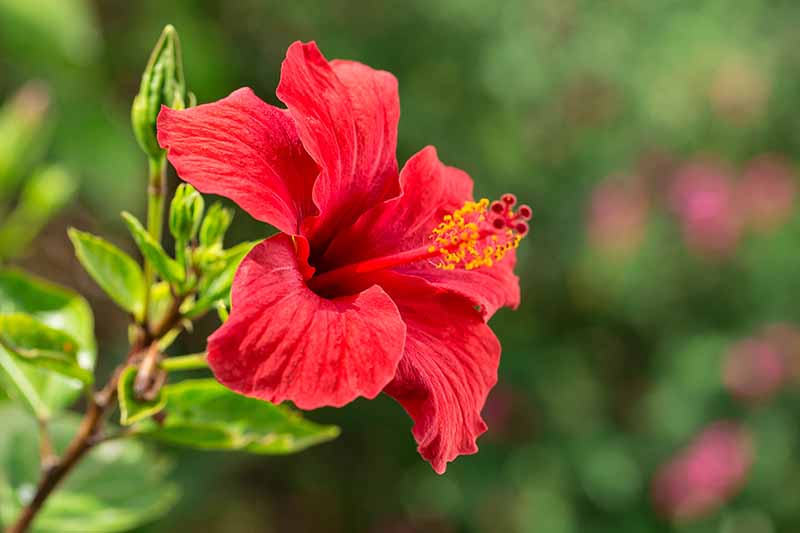
Another curiosity about the tropical species is that growers sometimes notice that the flowers on their “baby” plants are different from the flowers of the mother plant. Well, that’s because H. rosa-sinensis is a polyploid.
This means it has more than two sets of chromosomes, making it easy to create hybrids with different colors and characteristics.
These evergreens are frost tender, and enjoy a full to part sun location with well-draining soil. Remember that in their native environment they grow in hot, humid conditions.
If you grow them in containers, you’ll need to bring them indoors when temperatures drop to around 50°F. They’ll bloom through summer to late fall, with 6 to 8-inch flowers.
But what about Hawaii?
Remember how I mentioned the eight ancestors of the modern tropical hibiscus? Well, two of these originate in Hawaii. Today, most of what is found growing in Hawaiian gardens are hybrids of these original species.
The yellow hibiscus, H. brackenridgei, is the state flower, and it is commonly used in the Hawaiian lei, a garland worn around the neck as a symbol of greetings, love, and friendship.
37 of the Best Hibiscus Varieties
Now that you have a clearer picture of which types may do best in your garden and the growing conditions that they require, let’s take a look at some of the different cultivars that are available.
I’ve divided them into three main categories – the two hardy types, followed by the tropicals – and for some of them I’ve included links from our trusted affiliates where you can buy seeds or plants to grow in your own garden.
Hardy Hibiscus (H. moscheutos hybrids)
These native hybrid perennials are all suitable for growing in Zones 4-9, but in colder regions you may need to provide them with some winter protection, such as mulch or frost covers.
All of these varieties are deer-resistant, and will attract hummingbirds, butterflies, and other pollinators to your garden.
1. Berry Awesome
I’m not sure about berry, but these are definitely awesome. This 2019 Proven Winners Perennial of the Year™ winner is part of the Summerific® Series, trademarked and owned by Walters Gardens in Zeeland, Michigan.
With exquisite seven to eight-inch, slightly ruffled blooms in vivid pink, with a crimson eye, these flowers will certainly make a statement in your borders.
The dark green foliage provides the perfect backdrop to showcase these huge blooms that will grace your garden from July to September.
Fast-growing, this variety forms dense, compact shrubs, and grows up to four feet tall at maturity, with a similar spread. You can plant in containers to provide a dash of color on a patio.
One of the hardiest of the hardy varieties, ‘Berry Awesome’ requires no attention in the winter and it’ll pop back up in late spring, ready to adorn your garden with more of its berry awesomeness.
You can find live plants available at Burpee.
2. Blush
This absolute stunner, part of the Head Over Heels® series from hybridizers at the University of Georgia, is a patented cultivar formally known as ‘RutHib1.’ That’s because the gentleman responsible for this dazzling beauty is John Ruter.
I’m not head over heels with that name, but I’ll certainly blush when this six to ten-inch flower adorns my landscape.
Its delicate pink petals are offset by a large, deep red eye that almost seeps color, against the backdrop of red wine-colored foliage.
This compact variety grows to a mature height of two to three feet, with a three to four-foot spread.
Perfect for containers or planted in borders with flowers of different colors, these bountiful blooms will keep you blushing from early summer into fall.
The dark red foliage dies back in winter, returning in late spring.
You can find 18-month to 2-year-old plants available from Nature Hills Nursery.
3. Cranberry Crush
Here’s another stunner from the Summerific® series from Walters Gardens. ‘Cranberry Crush’ is an indeterminate variety, which means it will produce flowers all along the stems, not just at the tips.
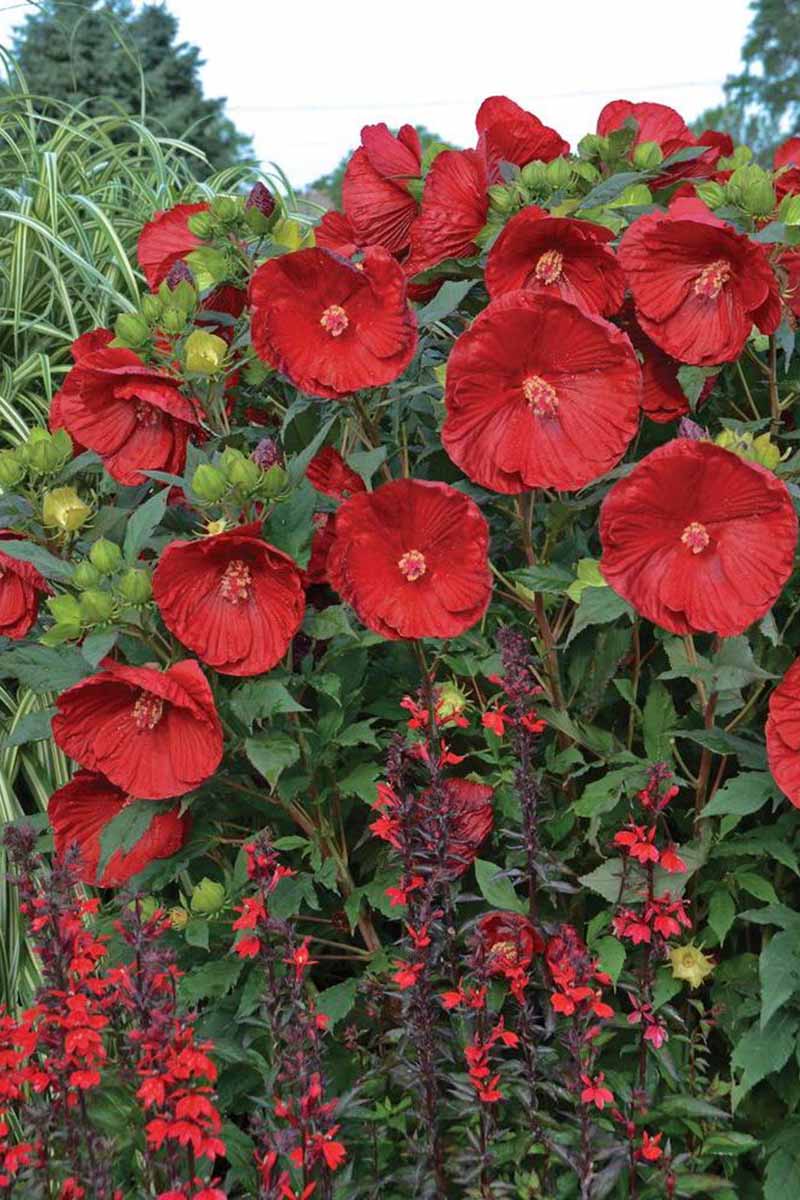
Bright red, with gently ruffled, overlapping edges, these seven to eight-inch flowers are slightly cupped – and emerge from almost black buds.
The bright green foliage, with purple veining, provides a perfect backdrop for the vivid red blooms.
With a mounding, compact form, this variety grows to a mature height of four feet with a spread of four to five feet, if you don’t prune it. A prolific bloomer, you’ll enjoy ‘Cranberry Crush’ from midsummer well into fall.
You can gaze at this beauty in borders, as a specimen plant, or even in containers on your patio.
‘Cranberry Crush’ plants are available from Burpee.
4. Honeymoon Red F1
Calling all container growers! If you’ve got a small space, but still want to enjoy big flowers on a more diminutive bush, look no further than ‘Honeymoon Red.’
This compact beauty grows up to two to three feet at maturity and spreads a modest two feet.
The deep red blooms are reminiscent of red wine – bold, velvety, and rich. Lightly ruffled, overlapping petals surround a white eye in the center, and against a backdrop of bright green foliage, make quite a statement for its small size.
A fast and vigorous grower, you’ll be able to have a honeymoon in your own garden (or patio) from July through September.
This variety is drought and heat tolerant, but like all hibiscus plants, don’t push your luck – water that baby.
You might be wondering what the “F1” means. It’s not a red Formula One car. This means the plant is a first-generation hybrid from two true to type parents, and will grow from seed. It’s not a hybrid of a hybrid.
Packets of five seeds for you to start your own honeymoon are available at Burpee.
5. Lord Baltimore
Hybridized by plant breeder Robert Darby in 1955, and named after Benedict Leonard Calvert, the 4th Baron Baltimore, who famously served as Governor of Maryland from 1684 to 1688.
He was just five years old at the time (Baron Baltimore, that is, not Robert Darby).
Well, I don’t know for certain whether Darby named his flower after this particular Lord Baltimore, as it’s more likely he’s referring to the 2nd Baron Baltimore, Cecil, after whom the city of Baltimore is named…
But I like the idea of a 5-year-old governing a state.
Digressions aside, this particular ‘Lord Baltimore’ is sterile, so he won’t be having any sons at all, let alone those that can govern.
He can only be propagated by division. The bold crimson flowers have slightly overlapping, ruffled petals, with a tiny white eye. They bloom on upright woody stems that grow four to five feet tall at maturity, with a two to three-foot spread.
His foliage is green, with maple shaped leaves, and he forms an upright, bushy mound – but tends to grow tall and leggy if he’s not pruned.
Thanks to his stately size, he’s good for planting at the back of borders, or as a specimen, governing his own little area of your garden.
‘Lord Baltimore’ plants are available at Burpee.
6. Luna Pink Swirl
Like raspberry ripple ice cream, ‘Luna Pink Swirl’ is a delicate blend of light pink that fades to creamy white across each of its five petals, in a picotee pattern.
Lightly overlapping, with a lipstick-red eye, this six to eight-inch flower makes a gentle, yet bold statement in the garden.
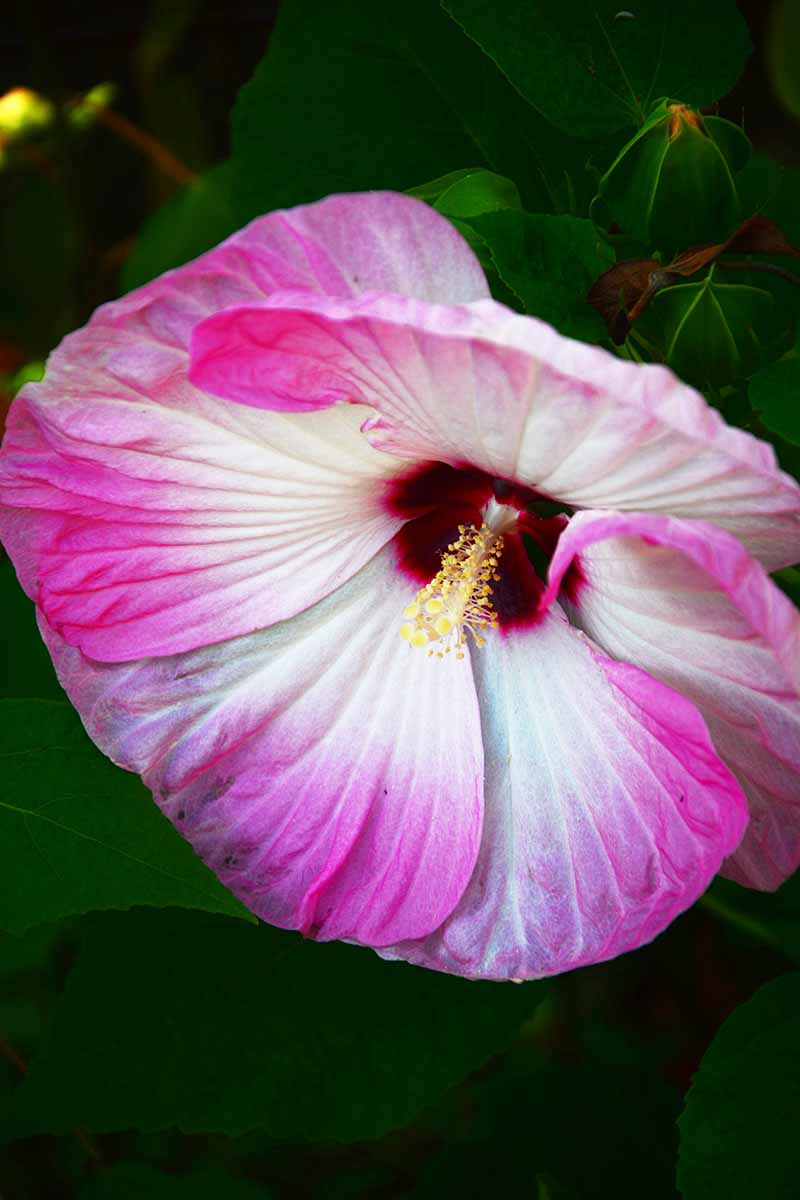
Developed by PanAmerican Seed, ‘Luna Pink Swirl’ is part of the Luna™ series of bushy, upright plants that grow to two to three feet tall at maturity, with a two-foot spread.
A vigorous bloomer, with dark green foliage that accents its large flowers, this shrubby perennial grows happily in borders, as a specimen bush, or in large containers.
The blooms last one to two days, and if allowed to, this plant will self-seed.
You can cut back the foliage after it has finished blooming in the fall, and wait for late spring to see signs of new life. If you are growing it in a container, provide a bit of extra protection during the winter.
Once it is established, this fast-growing variety is drought tolerant, and hardy to Zone 5.
Live plants in quart-sized containers are available at Nature Hills Nursery.
7. Luna Red
Another one from the Luna™ series, ‘Luna Red’ is, unsurprisingly, red.
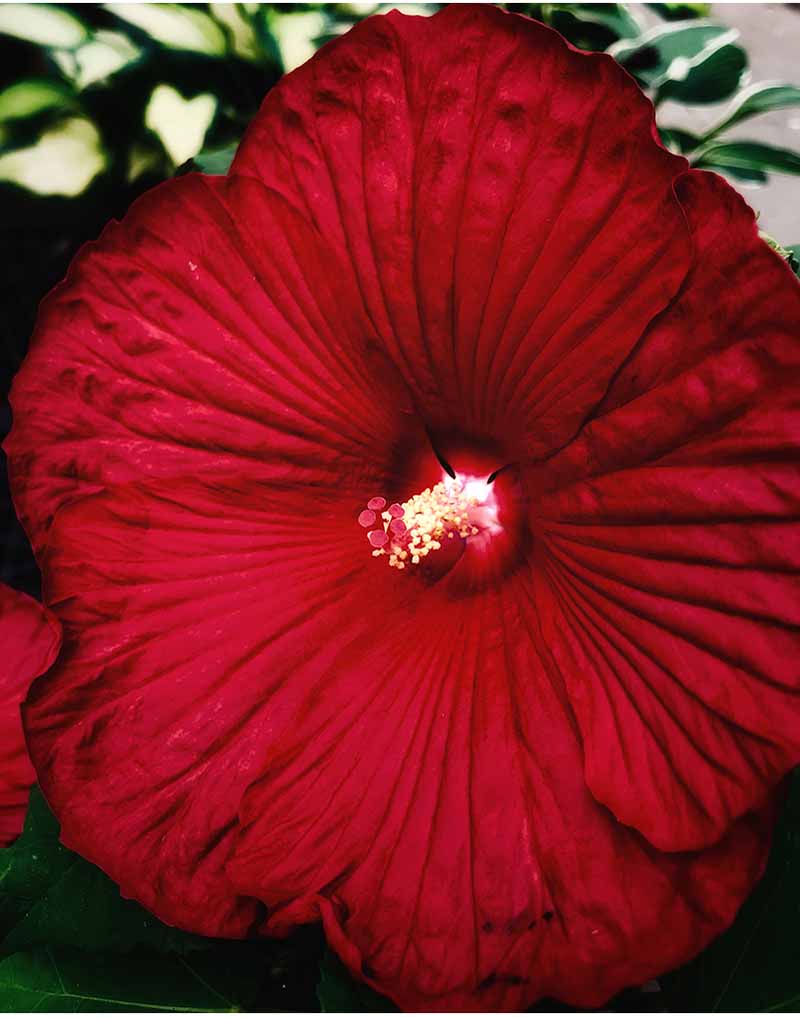
But these blooms can have a more pinky-red color, unlike the vibrant, lipstick-red of the ‘Lord Baltimore.’
Large, six to eight-inch flowers have overlapping petals and a slightly darker red eye, but it isn’t that noticeable.
Well-branched, it would make for a neat hedge if planted with others in the series. Alternatively, as with ‘Luna Pink Swirl,’ you can plant in large containers, borders, or as specimen plants in the garden.
Expect mature dimensions of two to three feet in height, and a spread of two feet. If kept in a full-sun location, you’ll have blooms from midsummer until late fall, although flowering will slow down as temperatures drop in the autumn.
Overwinter by cutting back the stems after the foliage has died back, and have patience, as you’ll likely have to wait until mid-May to see signs of life.
‘Luna Red’ plants ship in quart-sized containers from Nature Hills Nursery.
8. Luna Rose
Another dinner-plate sized beauty from PanAmerican Seed Company’s Luna™ series, ‘Luna Rose’ shares the compact, bushy form and six to eight-inch flowers of other members of this series, and is quite a looker.

I’d describe this one as “hot pink,” with her vivacious, bright flowers that jump out and surprise you.
If you like your pinks to last all the way to the first frost, then ‘Luna Rose’ will make the ideal addition to your garden.
As with the other members of the Luna™ series, this rose by any other name will top out at two to three feet high, with a modest spread of two feet.
Plant her with her Luna™ siblings for uniform flowers in a variety of colors.
Quart containers of live ‘Luna Rose’ plants are available from Nature Hills Nursery.
9. Luna White
Last up from the Luna™ series is this beauty.

Six to eight-inch blooms are a delicate, creamy white, with a dark, blood-red eye.
You can expect the same compact, bushy form as that of those described above, with a mature height of two to three feet, and a spread two feet wide.
The large flowers pair beautifully with other members of this series for a uniform shape, as part of a small hedge, or in sunny borders.
Hardy to Zone 5, you can overwinter in Zone 4, if you provide protection in the form of mulch or frost covers.
Once established, this one is drought tolerant, and will die back over winter, appearing again in late May to grace your garden with her spectacular, large blooms.
‘Luna White’ plants are available at Nature Hills Nursery.
10. Mars Madness
Our friends at Walters Gardens Nursery, in Zeeland, Michigan are never ones to rest on their laurels, bringing out new varieties almost yearly.
‘Mars Madness,’ another member of the Summerific® series, grows to an astronomical four to five feet tall with a five to six-foot spread at maturity.
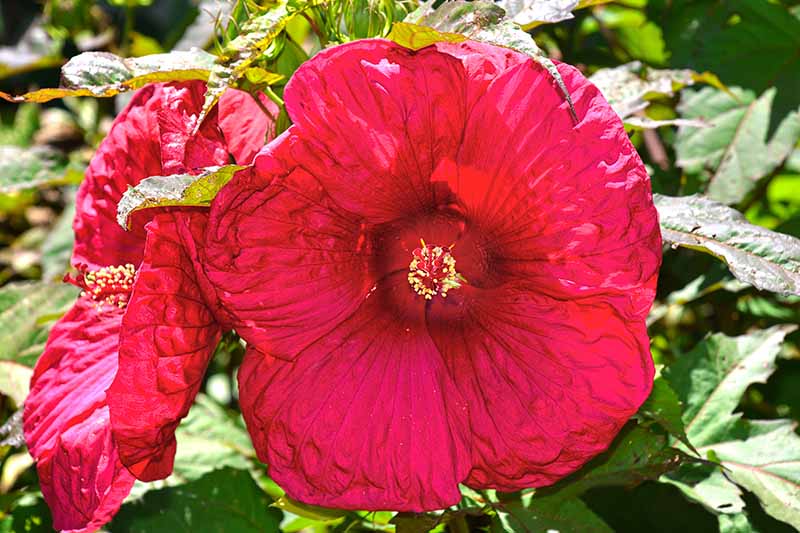
A big plant, like a big planet, sports dinner-plate sized flowers seven to eight inches wide, in deep fuchsia or cerise red, with a dark red halo in the eye.
Overlapping petals with deeply impressed veins give him texture.
The dark green, almost olive-colored leaves provide an impressive backdrop to the bold red blooms.
Flowers appear from top to bottom, making for an imposing specimen plant. This type is not suitable for containers – unless your container is the size of the International Space Station.
Hardy to Zone 4, this one is a late bloomer, starting towards the end of July and continuing the madness all the way up to the first frost.
A cold tolerant variety, ‘Mars Madness’ needs a full sun location and will benefit from a little pruning before the blooms appear.
Add some madness to your garden with plants available from Burpee.
11. Midnight Marvel
Another striking red beauty, this time from Kevin Hurd, hybridizer at Walters Gardens.

He bred this one from a cross between ‘Cranberry Crush’ and ‘Summer Storm’ in 2008, using a combination of sterile tissue and stem cuttings.
This is a patented variety and propagation is not permitted.
Dark purple foliage provides a dramatic backdrop to the scarlet blooms that emerge from almost-black buds.
The seven to eight-inch flowers have textured petals and a teeny-tiny bit of white that emerges from the eye. In fall, the foliage will turn to a vibrant orange color.
Growing to a fairly compact four feet high, and four to five feet wide, ‘Midnight Marvel’ forms upright, bushy mounds that die back in winter.
Hardy to Zone 4, it’s recommended that you protect the crown with a thick layer of winter mulch in the first year of growth.
You can find ‘Midnight Marvel’ plants available at Burpee.
12. Passion
Be prepared to fall head over heels in love with the enormous, bright pink blooms of ‘Passion.’ In fact, this is another member of the Head Over Heels® series – remember ‘Blush,’ described above?
Bred by John Ruter, and very boringly given the official moniker ‘RutHib2,’ the deep wine-red foliage will ignite your passion for this plant even before the flowers start to bloom.
Come July, the vivacious, pink, six to eight-inch flowers will emerge from their bright green buds, with a seductively deep red eye – lasting only one day, passion spent.
But they’ll be back again tomorrow, and all the tomorrows right up until late fall.
‘Passion’ grows in a compact, bushy form, with a mature height of just two to three feet and a three to four-foot spread.
You can confine your ‘Passion’ to containers, or give her pride of place at the front of borders.
Not quite as robust as some of the other varieties I’ve described, she’s really only hardy to Zone 6. She’ll go to sleep in the winter, and just when you’ve given up on her ever reappearing, she’ll surprise you – in May.
Plants in quart-sized containers are available from Nature Hills Nursery.
13. Starry Starry Night
Released by Walters Gardens in 2015, ‘Starry Starry Night’ is the variety I would pick if I was only able to choose one.
The foliage is deep inky purple, almost black – making a dramatic addition to any border. And that’s before she even starts blooming. From bright green buds come the real stars of the show – the eight-inch flowers.
With five pale pink petals with light purple veins, fading softly along a gradient of light pink to darker pink, the bright red central eye will have you mesmerized – and the hummingbirds, too.
Against the dark background of the foliage, the flowers seem to swirl with their variations of pink hue.
This variety is well-branched and will form a four-foot-high and equally wide clump, creating a bold centerpiece in a border or container garden.
Blooms will appear in midsummer and last all the way to the first frost. A full sun location is important for the dark foliage to develop.
Hardy to Zone 4, it’s recommended that you provide some winter protection in colder regions – thick mulch should do the trick. If you’re handy with the pruning shears, this one can be pruned into a small tree.
Plants are available for purchase at Burpee.
14. Vintage Wine
From almost black flower buds, set on dark green, heart shaped foliage, emerge the scarlet blooms of ‘Vintage Wine.’

I’m sure ‘Lord Baltimore’ would disagree, but according to the breeders at Walters Gardens, this one is considered an improvement on the stately ‘Lord Baltimore’ variety.
Forming a dense, upright stature, ‘Vintage Wine’ reaches a mature height of about four feet, and spreads to four to five feet wide.
The huge 8-inch flowers have slightly overlapping petals, with an ever-so-slight ruffled texture, and the scarlet deepens to a dark red eye.
Hardy to Zone 4, this vigorous grower will delight as an accent plant in borders, or a stately specimen when planted alone.
Find ‘Vintage Wine’ plants from Burpee.
Rose of Sharon (H. syriacus cultivars)
H. syriacus is native to China, and often referred to as rose of Sharon, or “common hibiscus” in North America. Hardy to Zone 4 or 5, they tend towards a taller, more shrubby, upright appearance than the US native hybrids.
H. syriacus will prove equally irresistible to hummingbirds and butterflies, and thankfully deer tend to give it a wide berth. Being a deciduous shrub, these plants will lose their leaves in fall.
The flowers usually have a more “ruffled” appearance than the H. moscheutos hybrids, a bit more reminiscent of the tropical hibiscus. They are also slightly smaller, at 3 to 5 inches in diameter.
Read on to find out more about some interesting cultivars with unique characteristics.
15. Aphrodite
Ah, Aphrodite, goddess of love. Who can resist falling in love with her delicate pink blossoms, with lightly overlapping petals that shimmy in the breeze?
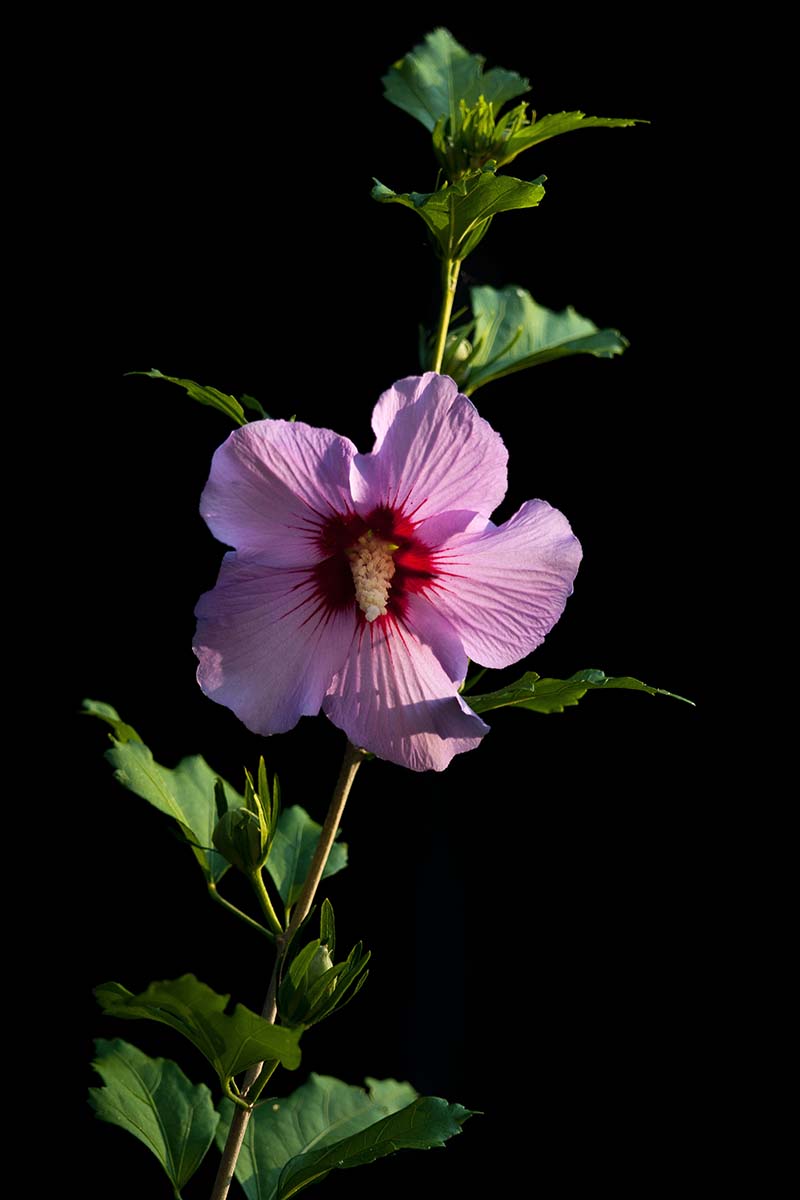
With a dark red, almost star-shaped eye to draw you in, her four-inch flowers will seduce you from midsummer into late fall.
Growing to a voluptuous eight to ten feet tall and six to eight feet wide at maturity, ‘Aphrodite’ can be pruned to a more manageable size, should you wish to contain her.
Her vase-like shape is well-branched and upright, with bright green foliage.
She’s hardy, unfussy about her soil, and will even withstand drought – but only for a short period.
To keep her blooming, she prefers a regular drink of water, and a sunny location. You can plant her as a hedge, at the back of borders to provide some height, or keep her alone as a specimen.
‘Aphrodite’ is easy to propagate from stem cuttings, but she’s sterile, so she won’t produce seeds.
Bare root plants are available at Nature Hills Nursery.
16. Blue Chiffon
It’s easy to see why ‘Blue Chiffon’ won an Award of Garden Merit from the Royal Horticultural Society.
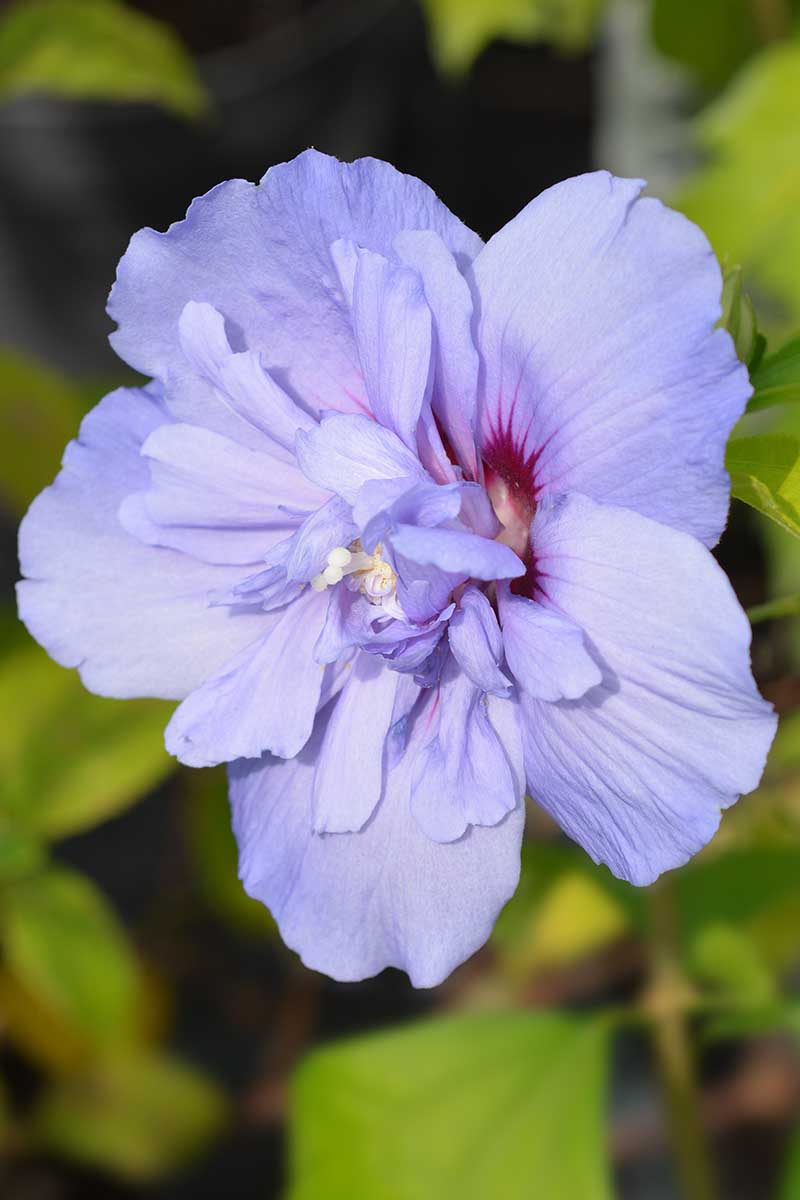
Her pale violet blue, four-inch flowers are semi-double, with five outer petals and a lacy center that gives her an almost frivolous appearance. She lacks the usual prominent stamen, it being covered by her inner petals.
If you look closely, you’ll see her reddish purple eye, just peeping out behind them.
The Chiffon® series was bred by Roderick Ian Woods in the UK by crossing various H. syriacus open-pollinated cultivars. Unimaginatively, ‘Blue Chiffon’ is also known as ‘Notwoodthree.’
Her rounded habit can reach a statuesque eight to twelve feet tall and a spread four to six feet wide at maturity, though she’s amenable to being pruned to a more manageable size.
Her pretty blue flowers will adorn your garden from midsummer well into fall, when she’ll take her leave and drop her foliage.
‘Blue Chiffon’ prefers moist, organically rich soil. But if she has to, she’ll manage in average soil, as long as it’s well-draining. Plant her in full sun and water well. Thanks to her size, she makes an excellent screen, or foundation planting.
Two to four-year-old plants ready to add color to your borders are available at Nature Hills Nursery.
17. Blue Satin
If you like your blues bold, then you’ll love ‘Blue Satin.’ The lightly ruffled petals are a deep blue on the outside, fading to a slightly lighter blue towards the eye.
The striking magenta eye seeps color along the petals, and contrasts with the light yellow stamen.
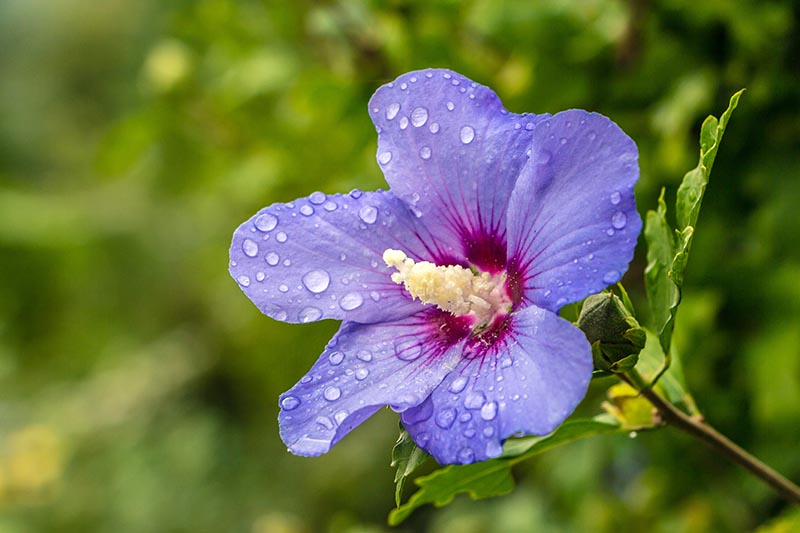
An upright, bushy shrub that grows eight to ten feet tall and four to six feet wide at maturity, its ovate green leaves provide a perfect backdrop to the colorful blooms.
This variety will tolerate salty soil and drought, but ideally it prefers even moisture, and organically rich soil.
For back of border height and structure, or as a hedge, ‘Blue Satin’ will delight with a multitude of three to four-inch flowers from midsummer well into fall.
Hardy to Zone 5, you can prune in spring, and propagate by stem cuttings.
You can find live plants in quart-sized containers from Nature Hills Nursery.
18. Blueberry Smoothie
If you want a hibiscus that you can prune into a tree shape, then ‘Blueberry Smoothie’ might be the one for you.
With four-inch, lavender blue, fully double blooms that look like crumpled paper, ‘Blueberry Smoothie’ will make a dramatic impression as a specimen tree in a container.
Bright green foliage offsets the ruffled flowers that appear in midsummer and last until the middle of autumn.
With an upright, spreading habit, if you want to keep it as a tree, you’ll need to get handy with the pruning shears.
Hardy to Zone 5, this variety will reach a mature height of up to eight feet, with a spread of four feet – if you let it.
‘Blueberry Smoothie’ looks great as an accent plant in containers, or you can grow it to add interest in borders and mass plantings.
Plant in full sun, in organically rich soil, and make sure to irrigate during dry spells.
Find live bare root plants ready to add to your garden available at Home Depot.
19. Lavender Chiffon
‘Lavender Chiffon’ is another semi-double variety, with light purple three to four-inch blooms and a fluffy center of petaloids. A red eye gently seeps scarlet veins into the outer petals.
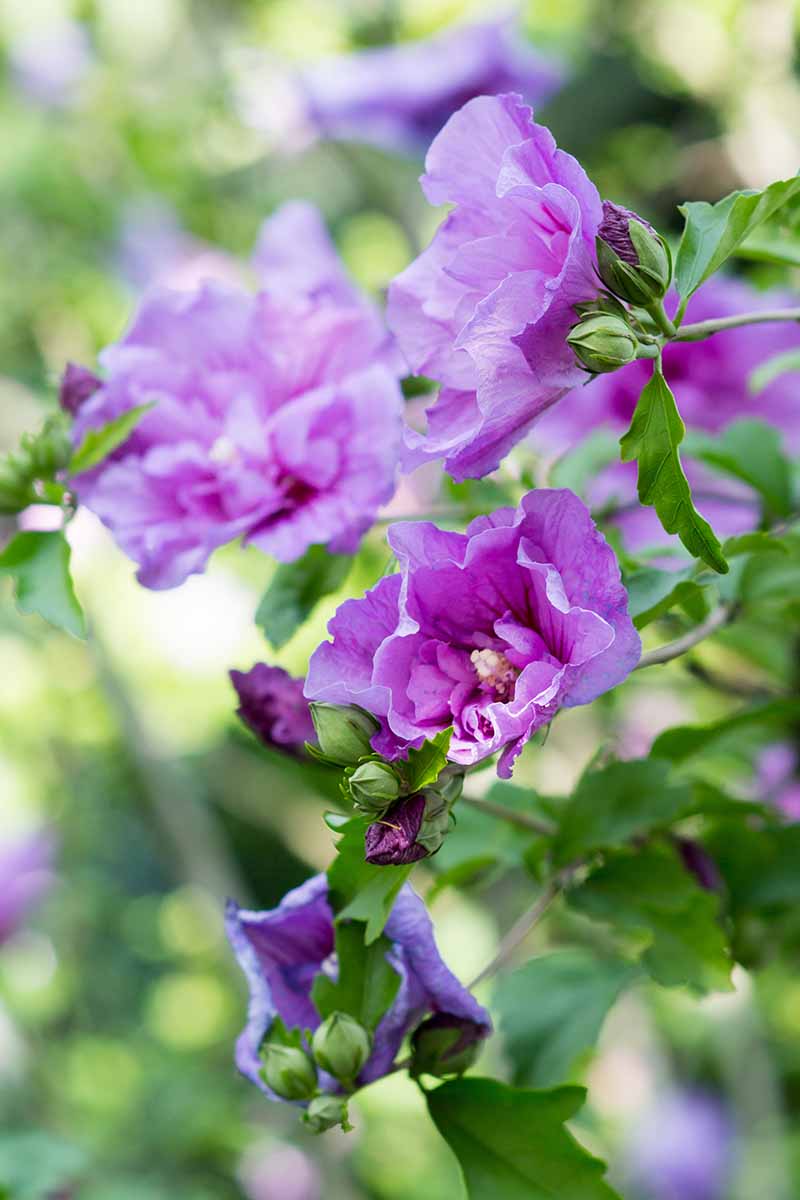
A winner of the Award of Garden Merit from the Royal Horticultural Society, this member of the Chiffon® series was patented in 2002 with the name ‘Notwoodone.’
As noted above, the hybridizer, Roderick Ian Woods, is better at breeding hibiscus than he is at naming them…
With dark green foliage, multi-stemmed ‘Lavender Chiffon’ has a rounded habit, and can be pruned into a small tree.
It grows up to ten feet tall, with a four to six-foot spread at maturity, and is a vigorous grower and bloomer.
Flowers make an appearance in July, and continue into autumn, when the plant will drop its leaves in preparation for winter.
This sterile variety can be propagated by cuttings and makes a dramatic addition to shrub borders, or in large containers for patio interest.
Plants are available at Burpee.
20. Lil’ Kim
Calling all small-space growers and container gardeners!
If you feel demoralized by all this talk of gargantuan ten-feet-tall hibiscus and are longing for a dwarf variety, this one’s for you.
Small in stature, but no less dramatic, ‘Lil’ Kim’ has three-inch white flowers with an enormous magenta eye that spreads dark red veins almost to the ends of her five petals.
Topping out at a compact three to four feet high with an equal spread, ‘Lil’ Kim’ is perfect for those small spaces, or even as a filler plant in a perennial border.
Ideal for containers, she’ll brighten your patio – plant in organically rich, well-draining soil and keep her well watered, in a sunny location.
Bred by noted horticulturalist Dr Shim Kyong-ku in South Korea, ‘Lil’ Kim’ is resplendent with her floral display from midsummer into autumn.
It’s recommended that you apply some balanced 10-10-10 (NPK) fertilizer in the spring, when you see new growth appearing. Especially if you are growing her in a container.
Two to four-year-old plants are available at Nature Hills Nursery.
21. Lucy
With her delightfully showy, rose-pink double-petaled flowers, ‘Lucy’ will add a pop of color to any landscape.
Her four-inch blooms appear in midsummer and add some much needed color to the early autumn garden.
Vibrant green foliage grows in an upright, well-branched vase shape that will top out at eight to twelve feet tall, and four to six feet wide.
Her abundant flowers are “true doubles,” the central petaloids being a little longer than the petals to give her a ruffled, slightly windswept appearance.
Vigorous, she can be pruned into a small tree, or left to her own devices as part of a mass planting or grown as a hedge.
To add ‘Lucy’ to your landscape you can find bare root plants available at Nature Hills Nursery, or one to two-year-old plants available at Home Depot.
22. Minerva
Introduced by the US National Arboretum in Washington, DC, ‘Minerva’ has luscious pinkish-lavender blooms with a bright red eye that spreads color lightly into the five ruffled petals.
A distinct ivory stamen contrasts with the vibrant colors of this cultivar.
With plentiful flowers throughout the summer, ‘Minerva’ will electrify your landscape, adding a burst of color to perennial borders, or alone as a specimen plant.
Dark green, glossy foliage grows on the well-branched, upright, dense form, and plants will mature to a height of six to nine feet tall, with a spread of five to seven feet.
This variety benefits from pruning, and can be grown in containers for a bright, bold statement.
Full sun and well-draining soil are essential, and make sure to water regularly during hot spells.
Prune in early spring, before flower buds have formed. And in the case of well-established, dense plants, thin out some of the older branches at ground level to promote airflow.
You can find bare root plants or live plants in quart-sized containers from Nature Hills Nursery.
23. Pink Chiffon
Another cultivar from the Chiffon® series (with their characteristically dull given names), ‘Jwnwood4,’ aka ‘Pink Chiffon,’ is another full-double variety.
Bright pink outer petals with crimson streaks from the deep red eye frame the central, fluffy petaloids.

With graceful stems, this cultivar can have a tendency to get somewhat “leggy.” It will grow to a mature height of eight to twelve feet tall, and four to six feet wide.
Pruning is recommended if you want to maintain a more bushy appearance.
‘Pink Chiffon’ enjoys a full sun location and will tolerate salty soil.
Grow in mixed borders, or enjoy as a specimen plant. The graceful blooms will adorn your garden from midsummer to late fall – when the dark green leaves will drop.
Find ‘Pink Chiffon’ plants available at Nature Hills Nursery.
24. Purple Pillar
The name gives us a clue as to what makes this variety unique: it grows in an upright column instead of having the wide, spreading form of most H. syriacus cultivars.
With a modest spread of only two to three feet wide, ‘Purple Pillar’ can reach a lofty ten to fifteen feet tall at maturity.
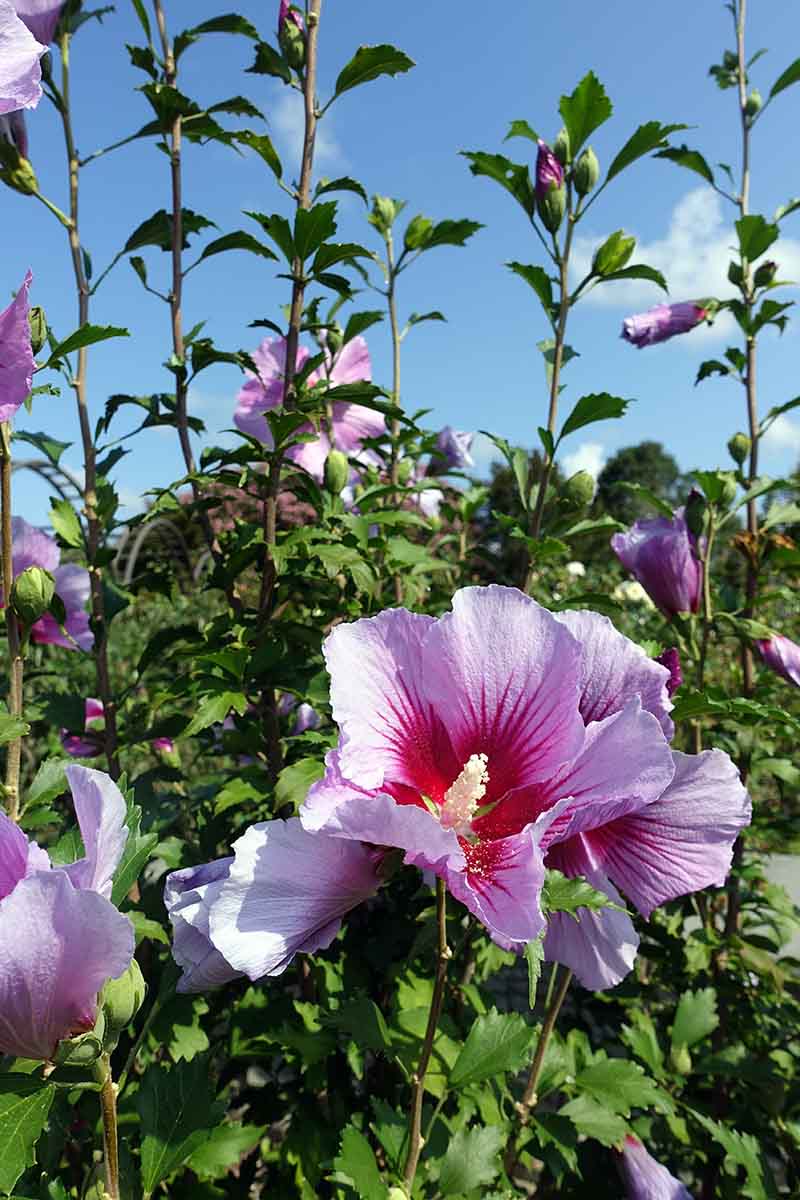
Purple semi-double flowers with a large red eye that extends almost halfway along the outer petals provide a truly bicolored appearance.
Small inner petaloids give the four-inch blooms a ruffled, windswept look.
The purple beauties adorn the upright stems from top to bottom from midsummer to fall.
The unusual upright habit makes this variety perfect for smaller spaces, as an accent plant beside an entrance way, or planted in containers.
It does not require pruning to maintain the pillar-like shape, although you can prune the top to prevent it becoming too tall.
This variety is also called ‘Gandini Santiago.’ It was first noticed by nurseryman Andres Santiago at a Spanish nursery, amongst a batch of seedlings.
The unusual flowers and upright growth habit piqued his interest.
He propagated this plant by cuttings and gave some to his friend Francesco Gandini, a horticulturalist in Italy.
Sadly, the Spanish nursery went bankrupt, but fortunately Francesco Gandini had seen the possibility of using Santiago’s plants as rootstock for grafting other hibiscus species. And so ‘Purple Pillar’ was born.
Plant in a full sun location with well-draining soil, and maintain even moisture. Hardy to Zone 5, ‘Purple Pillar’ will drop its leaves in fall, and come back resplendent in late spring.
You can find bare root ‘Purple Pillar’ from Nature Hills Nursery, or at Home Depot.
25. Red Heart
If you want to add a tropical look to your backyard, these snowy-white, four-inch flowers with a large scarlet eye that frames the white stamen cone might be just what you are looking for.
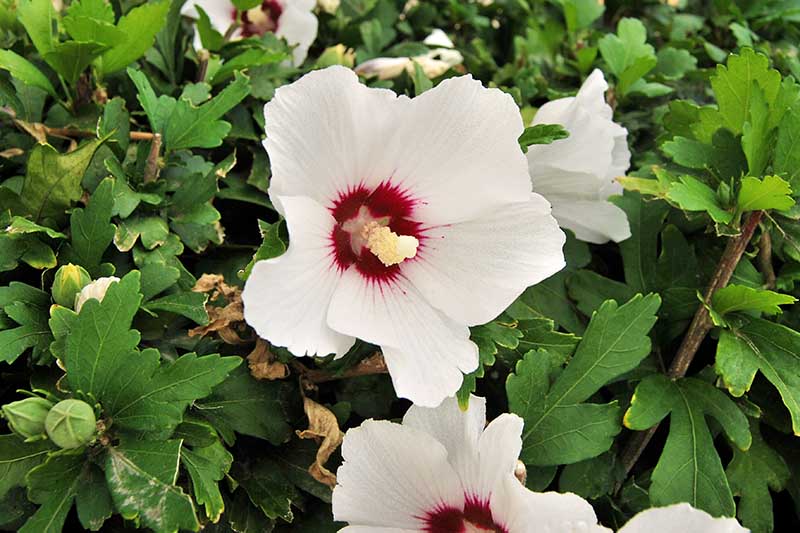
‘Red Heart’ makes an imposing statement in the landscape with bright green, toothed leaves and an upright growth habit.
A vigorous grower, ‘Red Heart’ will top out at ten to twelve feet tall, with a six to ten-foot spread.
You can prune into a tree shape, or let it run wild and fill a large gap in the landscape.
Enjoy as a specimen plant, grow two or more as an imposing hedge, or add to perennial borders for some lighthearted, tropical appeal later in the season.
As with most H. syriacus varieties, ‘Red Heart’ likes a sunny spot, and well-draining, moist soil. Leaves will drop in late fall, and plants will begin to fill out again in mid to late spring.
You can find bare root plants to add to your garden available at Nature Hills Nursery.
26. Sugar Tip
Marketed as ‘Sugar Tip,’ this cultivar is also known as ‘America Irene Scott,’ and was initially discovered in Missouri in 2001 as a sport (genetic mutation) of H. syriacus ‘Lady Stanley.’
What sets ‘Sugar Tip’ apart from other cultivars is her variegated foliage. Boasting blue-green leaves with white borders, this variety provides interest before she’s even started flowering.
And when she blooms, she doesn’t disappoint. Gentle pink, three to four-inch double flowers with hints of raspberry at the edges have five outer petals that frame the delicate ruffled petaloids in the center.
From midsummer well into autumn, ‘Sugar Tip’ will delight with her delicate blooms.
As a semi-dwarf variety, she grows five to six feet tall at maturity, with a four to six-foot spread.
‘Sugar Tip’ grows happily in containers, borders, or as a small hedge or privacy screen. She can tend to get a little “leggy” if you don’t prune, which is best done in the spring, as she flowers on new wood.
‘Sugar Tip’ plants are available at Burpee and at Home Depot.
27. Summer Ruffle
Another variegated cultivar, ‘Summer Ruffle’ has more pronounced variegation in its foliage than ‘Sugar Tip.’
Discovered as a sport (genetic mutation) of the hybrid cultivar ‘Ardens’ by propagator Steve Bruin at Lincoln Nursery in Grand Rapids, Michigan in 2003, it was patented as H. syriacus ‘Aarticus,’ and first brought to market in 2015.
The eye-catching blue-green and creamy white foliage grows on a compact shrub of only three to four feet tall and wide at maturity.
Perfect for container growing and smaller gardens, ‘Summer Ruffle’ will display her pinky-lavender, semi-double flowers from midsummer to late autumn.
The blooms sport a dark red eye, which is only just visible behind the central, ruffled petaloids.
Add to perennial borders, or grow it as a standalone feature plant in a sunny location. Provide moist, well-draining soil, and ‘Summer Ruffle’ will be an easy to care for addition to your summer garden.
You can find ‘Summer Ruffle’ plants that ship in spring from Nature Hills Nursery.
28. White Chiffon
We end our H. syriacus section with ‘White Chiffon.’

Delicate, snowy-white, semi-double flowers with ruffled petaloids provide an understated, soothing appearance set against the bright green foliage.
Four-inch outer petals frame the small, fluffy petaloids in the center.
Another member of the Chiffon® series, cultivated by Roderick Ian Woods, this one has been given the name ‘Notwoodtwo,’ in a feat of imaginative creativity.
‘White Chiffon’ received an Award of Garden Merit from the Royal Horticultural Society, and it’s easy to see why.
Fast growing, this variety forms an upright vase shape of eight to ten feet tall, and spreads four to six feet wide at maturity.
You can prune ‘White Chiffon’ in spring, as flowers form on new wood, and will grace your garden from midsummer to mid autumn.
‘White Chiffon’ can be planted as a gentle backdrop to colorful perennial borders, or as a hedge or privacy screen.
So long as you’ve got a full sun location, well-draining soil, and you provide even moisture, this variety will return year after year.
Plants are available in quart-sized containers from Nature Hills Nursery or from Home Depot.
Tropical Hibiscus (H. rosa-sinensis hybrids)
Growers in Zone 9a and below, look away now – unless you’ve got a greenhouse or intend to grow tropical hibiscus indoors. The following nine varieties are the tropical beauties, sometimes called “fancy” hibiscus.
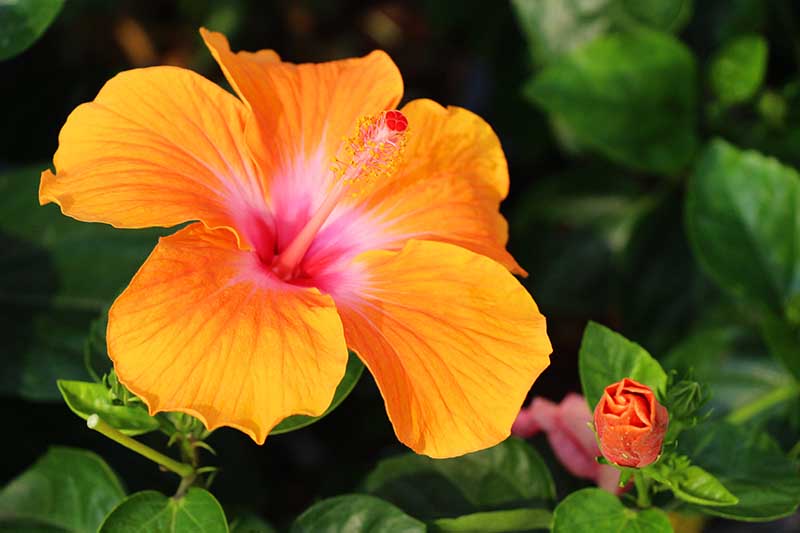
In their natural habitat they thrive in hot, humid locations, with a lot of sun and little to no cold weather. These evergreens need temperatures ranging from 60-95°F. They can survive the odd light, short freeze, but anything under 30°F for more than a few hours will likely kill these plants.
In the right conditions, these tropical varieties will bloom from early spring until late fall, adorning your garden with their magnificent colors on huge, elegant flowers.
All the varieties below are hybrids of H. rosa-sinensis, and the unique, ruffled flowers with long staminal columns will play host to a variety of different pollinators. This type of hibiscus is beloved by gardeners and artists alike.
Prepare to feast your eyes on these unusual cultivars and transport yourself to a tropical paradise.
29. Black Dragon
Dark and brooding, with deep burgundy tones, shades of black, and a swirling central eye that dots the edges of the petals with a smattering of white, ‘Black Dragon’ is one of the more unusual hybrids.
A sport of ‘Dragon’s Breath,’ this eight to ten-inch flower will add drama and flair to your tropical garden.
However, it’s a tricky one to grow. Plants have been known to die suddenly from stresses such as over- or under-watering.
Awarded Hibiscus of the Year in 2005 by the American Hibiscus Society, this slow-growing shrub can be kept in containers, planted as a specimen, or used to add interest to mixed tropical plantings.
The blooms will be darker in midsummer and fade to more reddish hues as the temperature drops.
As it has quite an open, spreading habit, you may need to stake the branches, or allow them to spill over the sides of containers.
In ideal conditions, ‘Black Dragon’ will grow up to three to six feet tall and wide at maturity, and can be pruned in spring to keep its shape. It needs well-draining, fertile soil, and won’t tolerate waterlogged, or very dry conditions.
30. El Capitolio
Originally from Cuba, the heritage of ‘El Capitolio’ is unknown. It’s not a hybrid developed by a clever breeder, but the result of Mother Nature at her most creative.
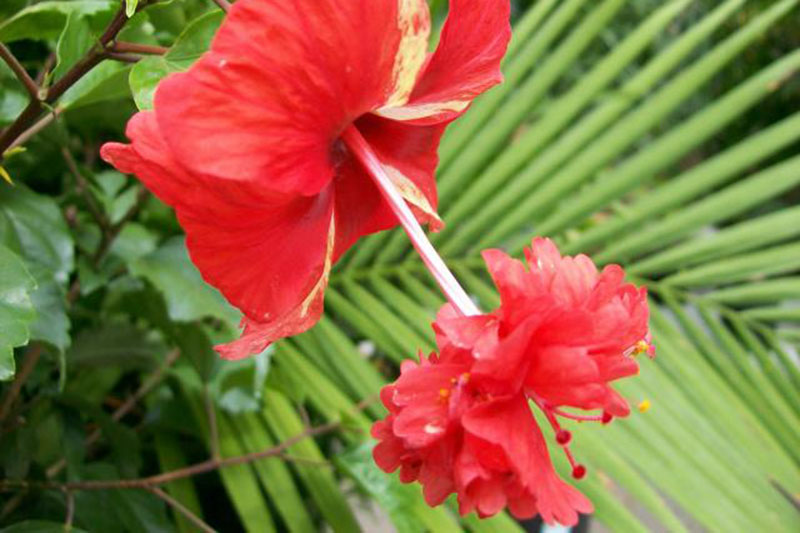
A bright red, four to five-inch flower opens up one morning, as you would expect, with ruffled petals, and the characteristic long staminal column.
But what’s this? ‘El Capitolio’ is unique as it develops petals on the end of the column, giving you not one, but two flowers in one bloom!
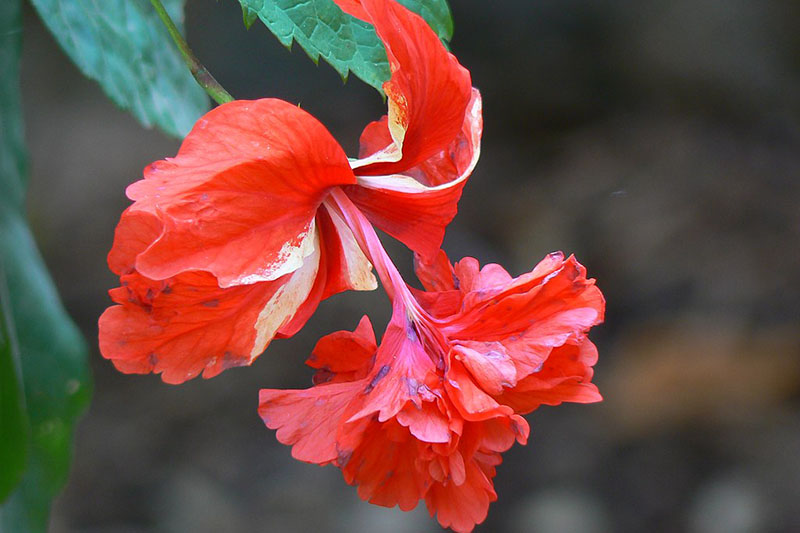
Delicate splashes of white from the central eye dot the scarlet blooms, adding to its unique charm.
Also known as a “poodle flower,” this variety is a vigorous grower, and in the right conditions can reach six to eight feet tall at maturity, with a four to five-foot spread. Bright green foliage offsets the vibrant red blooms.

‘El Capitolio’ will flower throughout the year in the right conditions and makes a stunning accent plant. It can also be pruned into a tree shape, planted in mixed borders, or grown as a hedge.
You can find ‘El Capitolio’ in four-inch pots from Emerald Goddess Gardens via Amazon.
31. El Capitolio Sport
Also known as ‘Lion Tail’ hibiscus, ‘El Capitolio Sport’ is, as you may have guessed, an offspring of the ‘El Capitolio’ type described above.
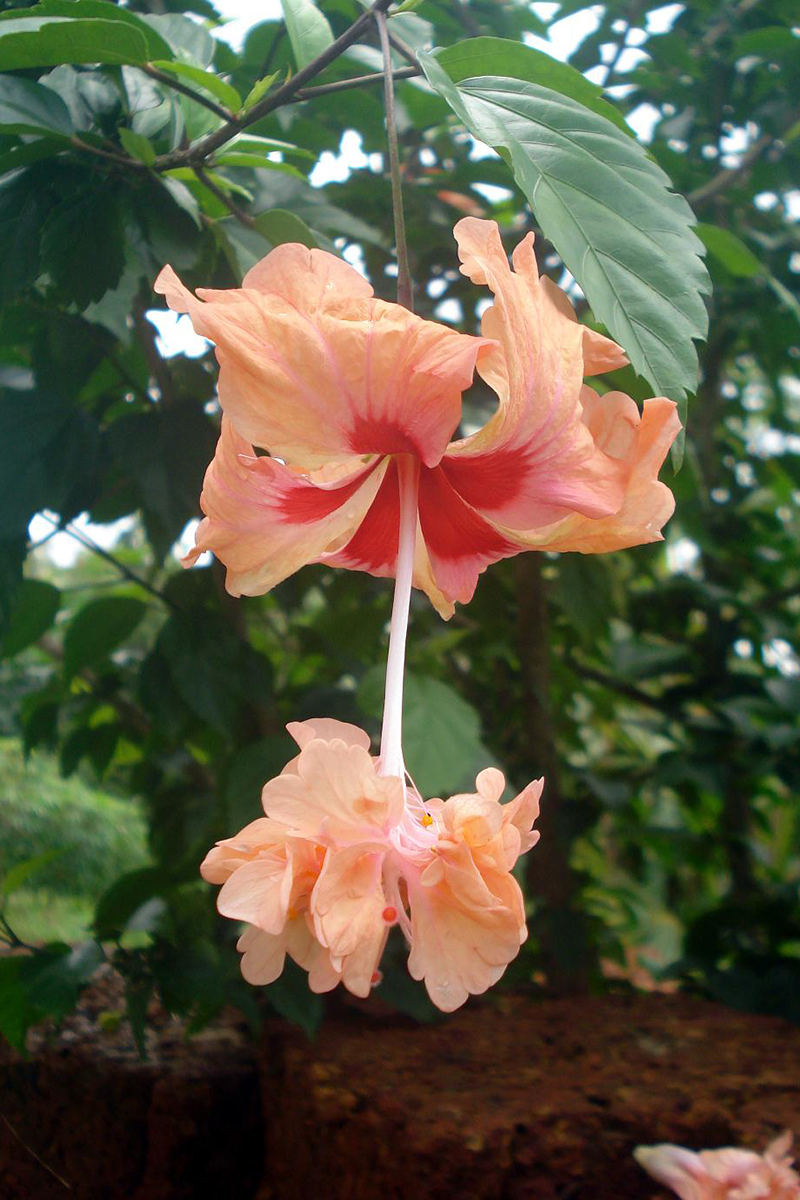
With its characteristic pom-pom flower, this variety is a more gentle peachy-yellow color.
But the central red eye that fades to light pink gives this flower an exquisite punch of color.
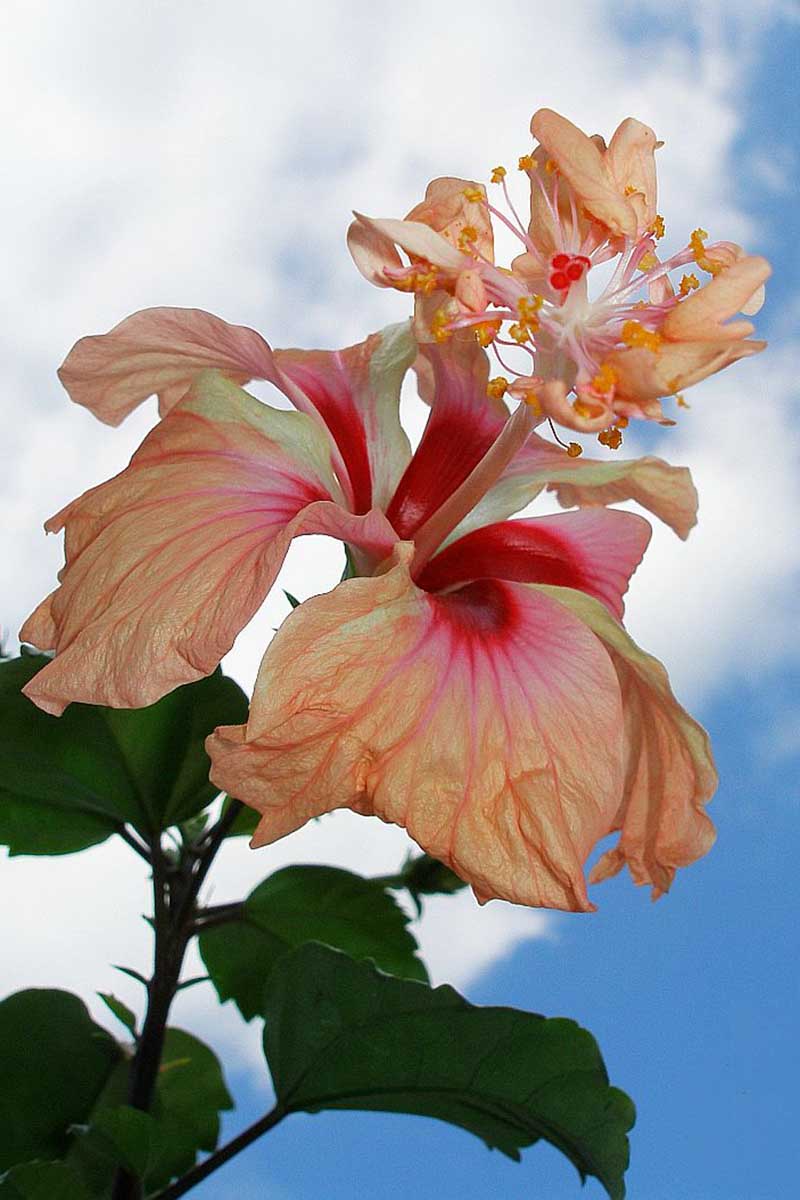
Reaching a lofty eight feet tall, this variety responds well to pruning, and will grow vigorously under the right conditions.
Plenty of sun, adequate water, and rich, fertile soil will have this beauty gracing your landscape with its unusual flowers year after year.
32. Eye of Kali
With vivid, golden-yellow petals with a large, bright red eye ringed in pink, ‘Eye of Kali’ will give your garden a tropical punch.
Her four-inch flowers bloom profusely on a strong, upright shrub that lends itself well to container growing or livening up a border.
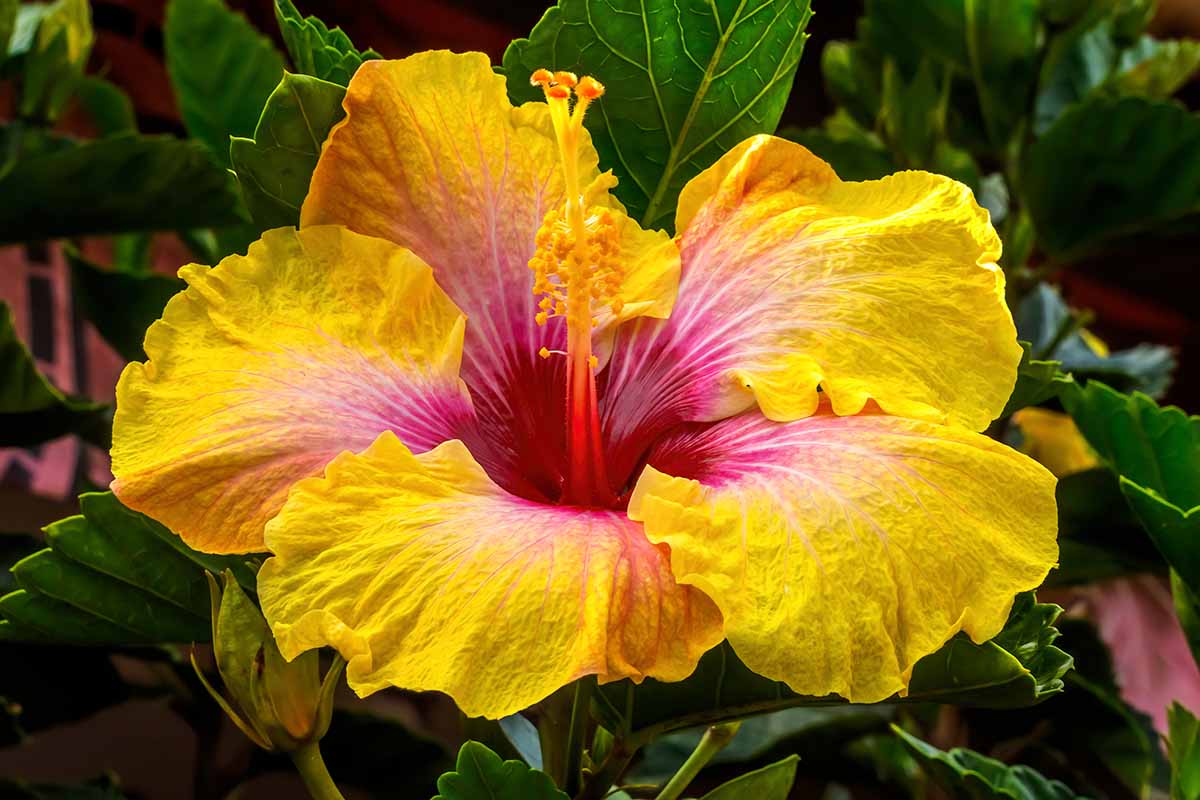
Hybridized by Dupont Nurseries in 2009, ‘Eye of Kali’ is part of their Cajun series. Reaching four to six feet tall and wide at maturity, this cultivar responds well to pruning.
Suitable for Zones 9 and above, you will need to provide adequate winter protection, as – like all the tropical varieties – she will not survive a hard frost.
In fertile, well-draining soil, with plenty of sun and adequate water you can enjoy her delicate, dramatic blooms almost year-round.
33. Fiesta
Get ready for a festival of color with the vibrant tones of ‘Fiesta.’ Bright, firey orange petals with crinkled edges give way to a golden-yellow margin.
The bright red eye fades to a pink halo, giving it a beautiful multi-colored appearance.
The carnival colors of the six to eight-inch blooms are framed by bright green, shiny foliage, and the flowers will last up to three days.
With an upright spreading habit, this variety responds well to pruning and you can persuade her into a tree shape, or a compact, low shrub.
Plant in containers or borders for a splash of tropical sunshine in the backyard.
Left to her own devices, she can reach a mature height of eight feet, with a spread of six feet. She’ll grow quickly in the right conditions: fertile, moist soil and lots of sun.
‘Fiesta’ plants are available in three-gallon containers from Home Depot.
34. Hawaiian Sunset
Another dazzling orange beauty, ‘Hawaiian Sunset’ will have you reaching for the mai tais and imagining yourself on a tropical island.
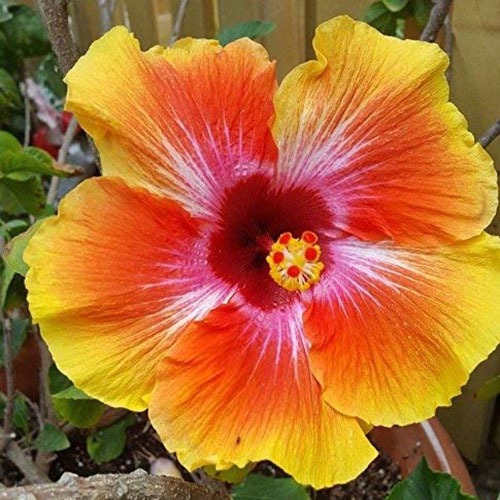
A vivid, bright red eye gives way to pinks and reds, with golden sunset-yellow at the edge of her six to eight-inch petals. Occasional white streaks add texture to this already exquisite blossom.
A sport of ‘Florida Sunset,’ this variety has deep green leaves with serrated edges, and will reach a mature height and spread of four to six feet.
As with most other tropical hibiscus cultivars, it thrives in containers and can be pruned to suit your garden style.
A prolific bloomer, you’ll have daily sunsets in your own garden if you provide well draining, rich, moist soil, and plenty of sunshine.
35. Nairobi
I’ve included the lesser-known cultivar ‘Nairobi’ as a nod to my childhood, as it was in Kenya that I first became enchanted by hibiscus.
With bright orange blooms with coral pink overtones, and a red central eye, ‘Nairobi’ is reminiscent of an African sunset.
A less vigorous grower than some of the other cultivars, ‘Nairobi’ will take her time to mature to a height of four to five feet, with a similar spread.
It’s recommended to keep ‘Nairobi’ in containers. Prune before and after blooming to encourage new growth, and for the slightly “leggy” form to fill out.

Provide rich, well-draining soil, and fertilize twice a year for best results. ‘Nairobi’ will thrive in a full sun location, with evenly moist soil.
Emerald Goddess Gardens has ‘Nairobi’ for sale in four-inch starter pots, available via Amazon.
36. Painted Lady
Probably one of the better known and recognizable varieties, ‘Painted Lady’ is a classic.
Huge, eight-inch scarlet red to dark pink petals with white striations surround a deep red eye.
The large green leaves with scalloped edges allow her vivid color to really pop.
A vigorous grower, this lady takes an upright, rounded form, with dense foliage and a mature height of six to eight feet, and a four to six-foot spread.
Prune her however you like, just be sure to do it before or after flowering. ‘Painted Lady’ will grace your patio in containers, or add a splash of red to borders.
Moderately salt tolerant, ‘Painted Lady’ loves the sun, rich, fertile soil, and a good drink of water. But remember, ladies don’t like wet feet, so avoid over-watering.
Find ‘Painted Lady’ in three-gallon containers available from Home Depot.
37. Seminole Pink
With delicate, bubblegum pink, six-inch blooms, ‘Seminole Pink’ brings gentle beauty to the tropical landscape.
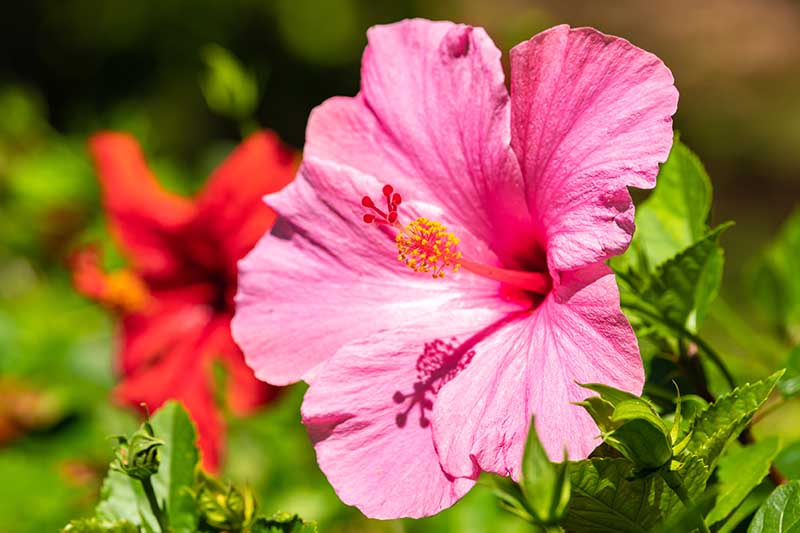
A deep red eye fades softly into the lightly ruffled petals that stand out in contrast with the light green foliage.
Combined with ‘Painted Lady’ or alone as an accent plant, ‘Seminole Pink’ grows happily in containers or borders, reaching a mature height of ten to twelve feet, and a spread of three to four feet.
The upright, rounded growth habit can be pruned into a tree, or shaped into a more compact form.
Bring some elegance to your landscape with these delicate, yet vivid blooms. ‘Seminole Pink’ is available in three-gallon containers from Home Depot.
Memories in Red, With a Silver Lining
I started this article from a memory. A memory of a beautiful red flower that enchanted my childhood.
So it’s fitting I end it with ‘Silver Memories.’ Six to eight-inch blooms in tones of silvery white to light purple, fading to golden yellow at the edges.
Sometimes with hints of pink and lavender, this cultivar does not grow by itself – it’s a graft-only variety.
Beautiful, ephemeral, and hard to come by – it’s bred by dedicated, specialist hibiscus growers. I’d love to find ‘Silver Memories’ for my garden, but as yet have found nobody who is willing to part with one.
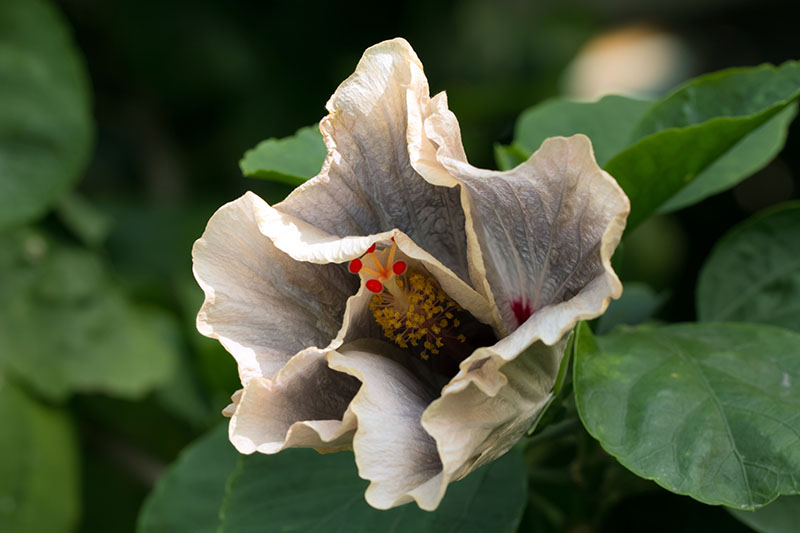
So for now, I’ll tend my memories with vibrant pinks, reds, and oranges – and hope that one day I’ll be lucky enough to make some new, silver memories.
With a color palette to suit every garden style, from the whimsical to the dramatic, it’s hard not to be charmed by hibiscus flowers.
I’ve cleared a large area along my fence line, here in my Zone 9b garden, and now my biggest problem is choosing which ones to plant.
I love all of them, and as a nod to my mother’s garden, I’ll definitely be putting in the tropical red ‘Painted Lady,’ flanked by some of the hardier varieties. I just have to hope I can tend her through the winter months.
With a little planning, you too can add hibiscus to your garden, and delight in the huge blooms with their glorious bursts of color through summer and into fall. Just find a sunny location, make sure you’ve got organically rich, well draining soil, and water regularly.
Have you tried growing hibiscus? Are you inspired to add any of these to your garden? Let me know in the comments, and please share your pictures!
And if you are looking for more information about growing flowers in your garden, you’ll need these guides next:
- How to Grow Bleeding Hearts
- How to Grow China Aster for Color in the Late Summer Garden
- How to Grow Garden Pinks for Old Fashioned Charm
© Ask the Experts, LLC. ALL RIGHTS RESERVED. See our TOS for more details. Product photos via Amazon, Burpee, Emerald Goddess Gardens, Home Depot, Nature Hills Nursery, Proven Winners, and Proflower1. Uncredited photos: Shutterstock. With additional writing and editing by Allison Sidhu.


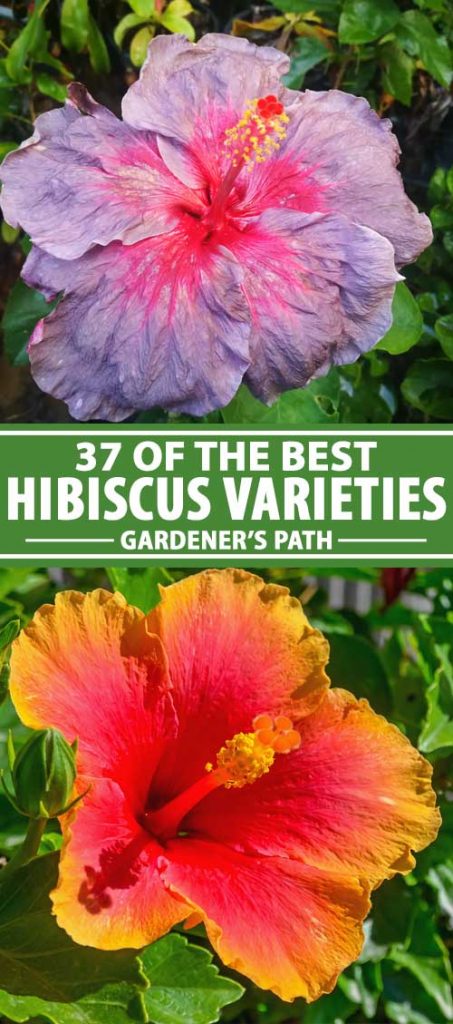
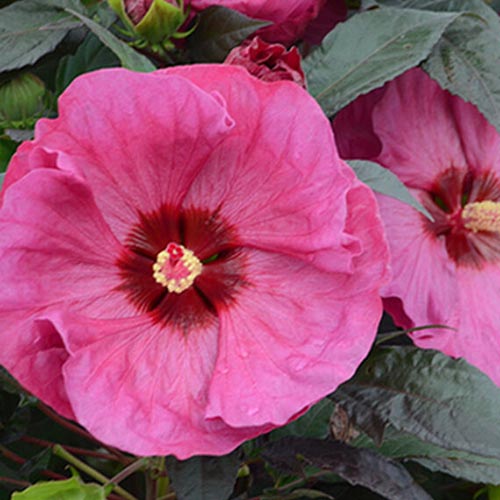
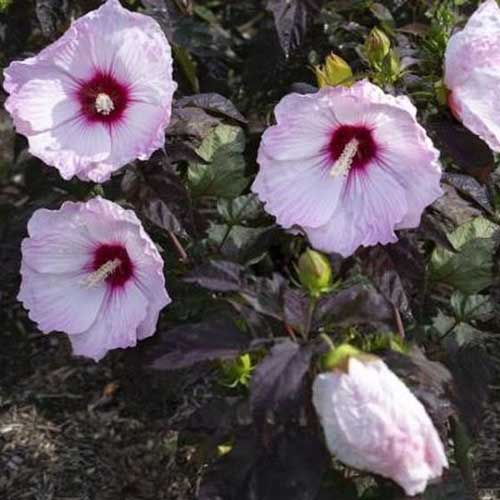

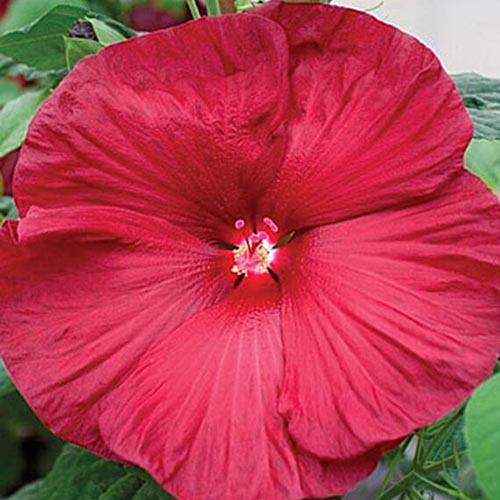
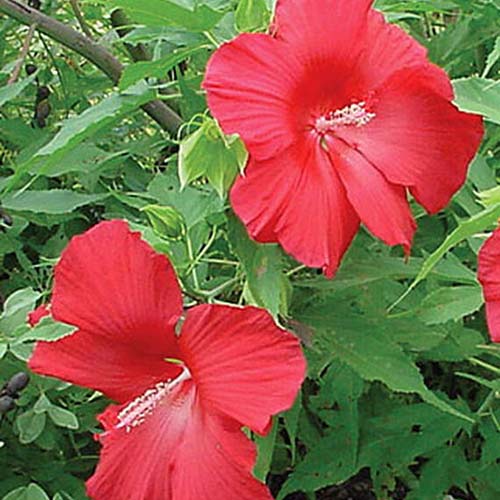
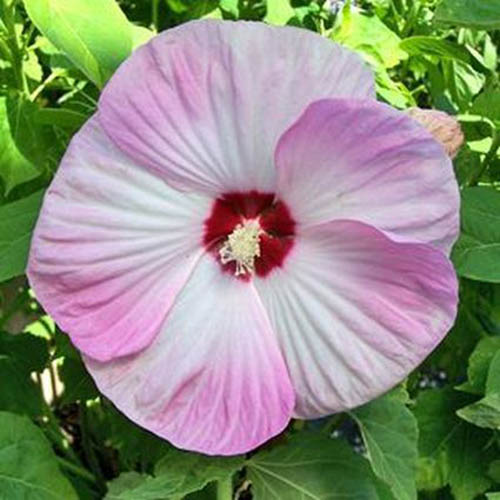
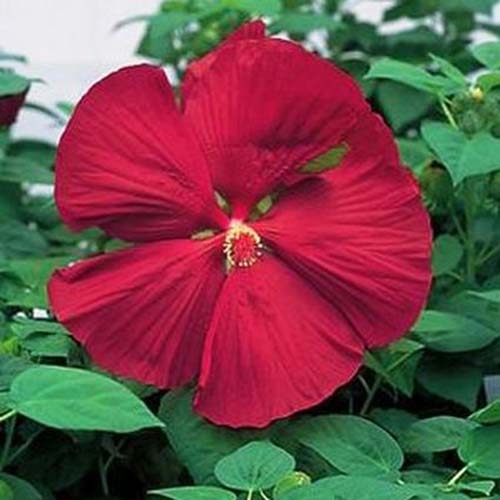

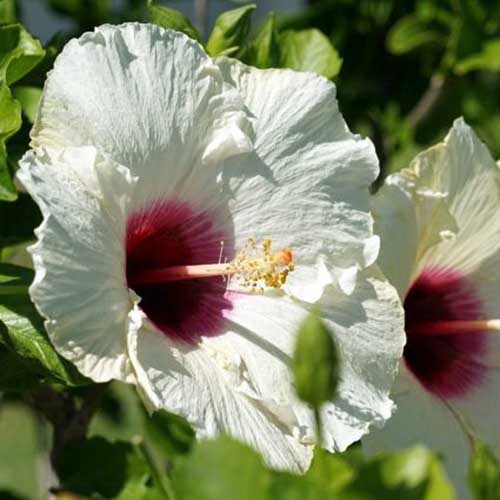


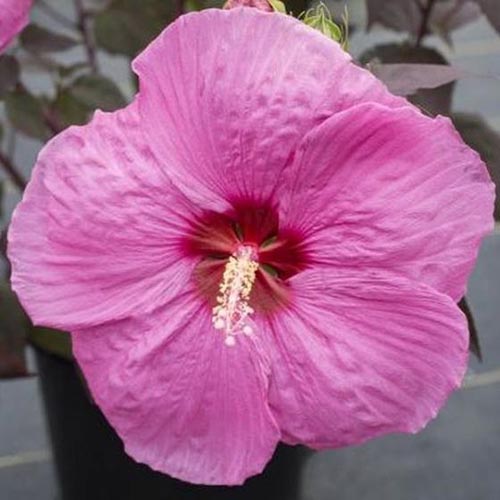


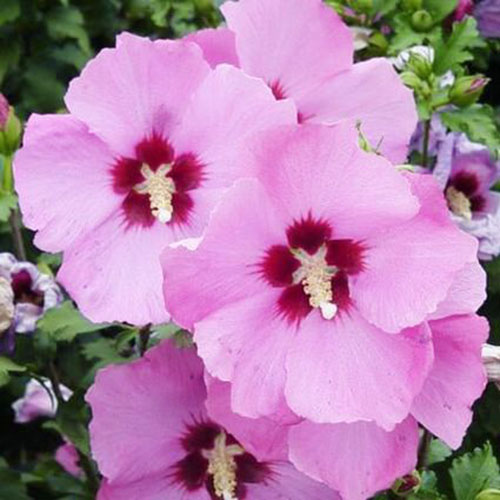

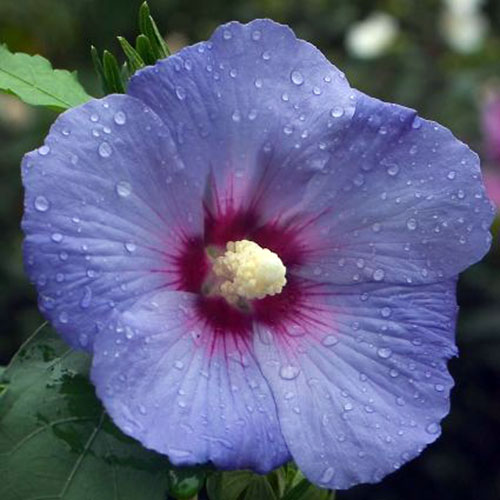
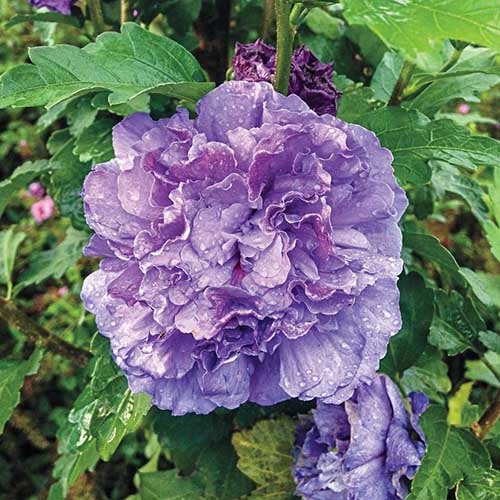
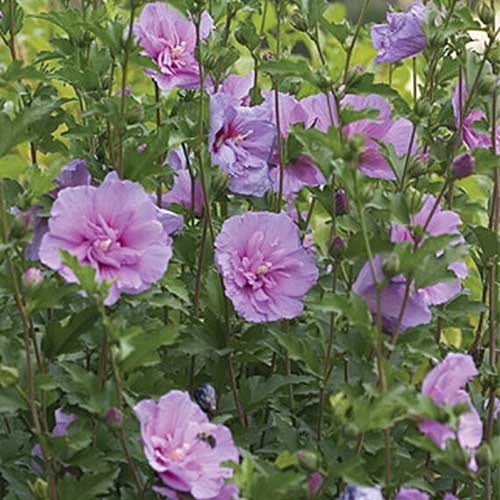
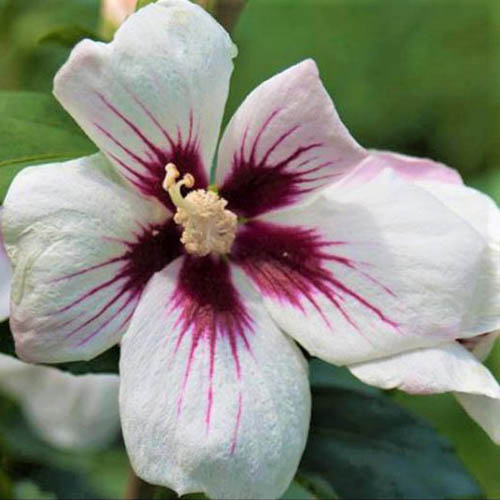
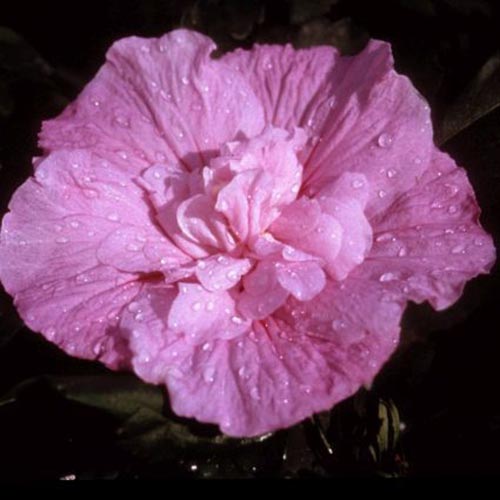

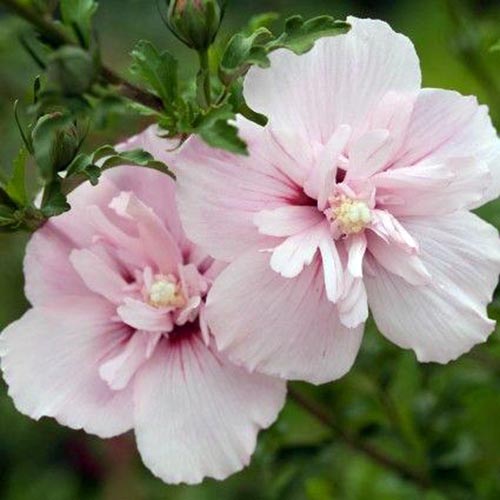

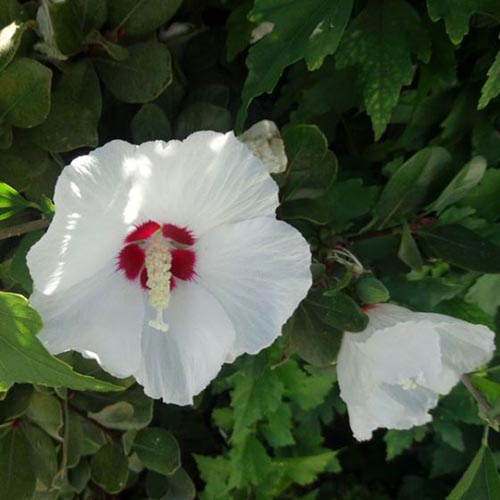

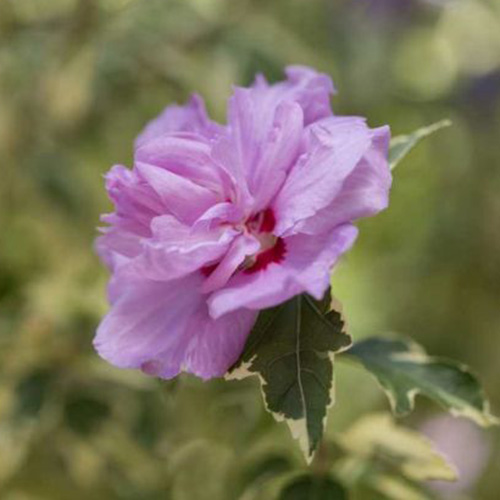
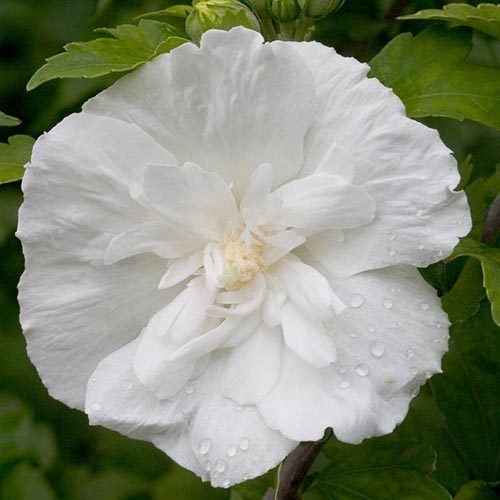
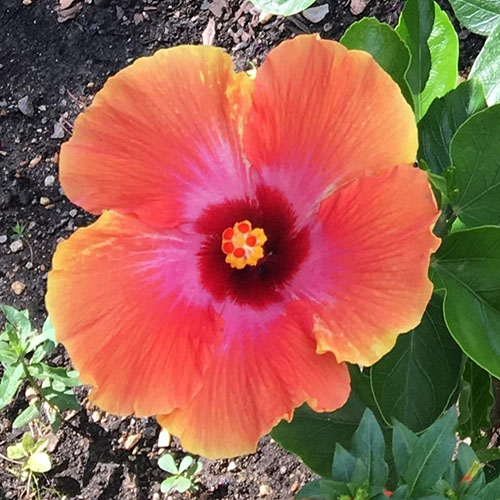
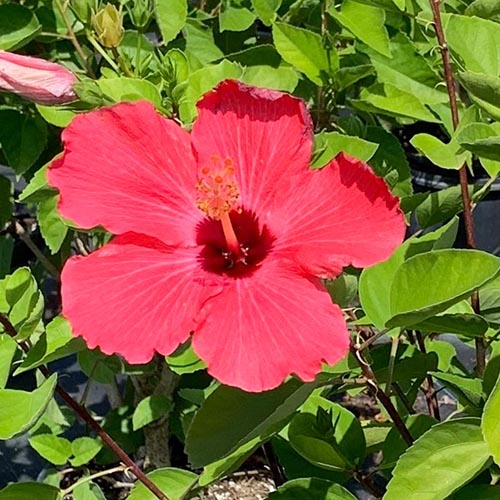
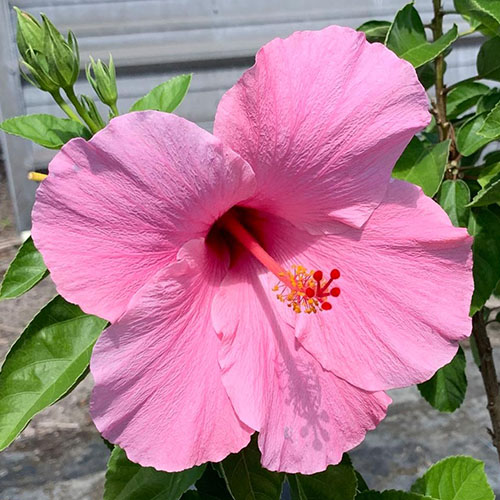
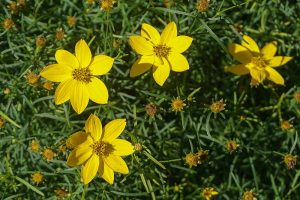


I was given a Midnight Marvel as a retirement gift. Now I have time to garden! I live in zone 8 and it’s doing well. Here’s a picture of it the first year. Thanks for your article and advice. I am going to add more hibiscus to my yard.
Hi Karen,
Wonderful! Looks like your photo didn’t upload- maybe it didn’t meet the image size requirements? We’d love to see it!
Thanks, what are the image requirements? I could not find them posted on the site.
Hi Karen, I found your picture! Your Midnight Marvel looks fantastic. Thank you for your kind words. That’s a cute dog you’ve got, too!
I have a pale yellow flower that looks like a hibiscus. It’s a few tall stalks, some are 6-7’ tall.
I’ve attached 2 pictures.
Pics of flower
Hi Sherri,
Those are hollyhocks, members of the Alcea genus. Aren’t they pretty? Hollyhocks are from the same family as the hibiscus (mallow, or Malvaceae) and share some similarities. Personally, I love them.
Thank you for sharing!
I live in zone 8b and I’m interested in planting “White Chiffon” hibiscus. The guide says it needs full sun. My area has full sun all morning and until about 2 pm then all afternoon shade. Is that enough sun for it to bloom? Also, most hibiscus are deciduous, but the information given says it can be used as a hedge. Does that mean it will keep it’s leaves all winter?
Hi Margie, ‘White Chiffon’ is gorgeous! Great choice. In Zone 8a you should be fine with morning sun and afternoon shade for a hardy hibiscus like ‘White Chiffon.’ And yes, you can prune it into a hedge, but it will drop its leaves in fall, and can look a big scraggly. This variety has a lovely, rounded shape and unless you really wanted a hedge, I’d be inclined to plant it at the back of a border or as a standalone shrub. In my opinion, they make good privacy screens in summer, but in winter, not so much. For more… Read more »
I am horrible at plants of any type but have always loved Hibiscus. My friend gave me one and I have done everything possible to keep it alive! Am proud to report it’s thriving and may end up getting another one next summer! I live in zone 7a
Hi Lori, thank you for sharing, your plant is beautiful! It’s a tropical hibiscus, so you’re doing really well to keep it thriving in Zone 7a. I love the red fading to yellow at the edge of the petals, just glorious!
We have just realized we have Florida Sunset hibiscus. We are in zone 4 or 5. Do we need to bring these inside in the winter?
Hi Diane, ‘Florida Sunset’ is beautiful! It’s a tropical hibiscus, H. rosa-sinensis, so it is very sensitive to the cold. Temperatures below 50 degrees can kill the plant, so I’d recommend you bring it indoors during the winter months, and try to maintain it at a temperature of between 60 and 75 degrees. Good luck with your plant!
Hey, can somebody please tell me which variety of hibiscus this is?
Thank you
Hi Abhinav, that’s a beautiful flower! It looks to me as though it may be a Hawaiian hibiscus. Can you upload a picture of the foliage?
I live in Durban South Africa and would love to purchase some of these exquisite hibiscus plants. Please advise if they are available. Kind regards.
Hi Gerald, you might be able to find hibiscus at Bloomingdales Garden Center or Hingham Nursery, both are in Durban North.
Hello I am an amateur artist and would love to use one of these flowers for a drawing. Please let me know if I am able to or if there is any way to use them.
thanks!
I would recommend you join the American Hibiscus Society at americanhibiscus dot org. They have much knowledge to pass along about growing (and finding) tropical hibiscus.
I have grown ‘Silver Memories’ before. A relatively sparse bloomer, but wonderful when there are blooms.
Hi George, I agree the American Hibiscus Society has a wealth of knowledge. I’m fascinated to hear that you have grown ‘Silver Memories.’ I’d love to get my hands on one, but they are pretty hard to find!